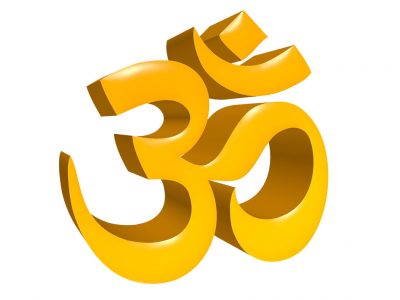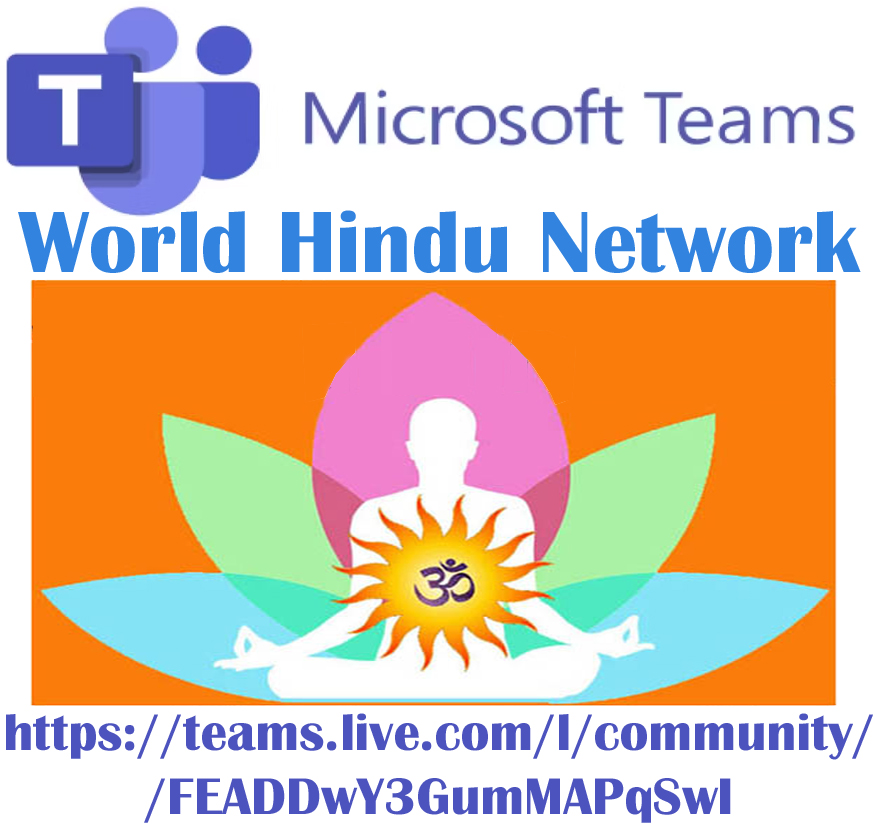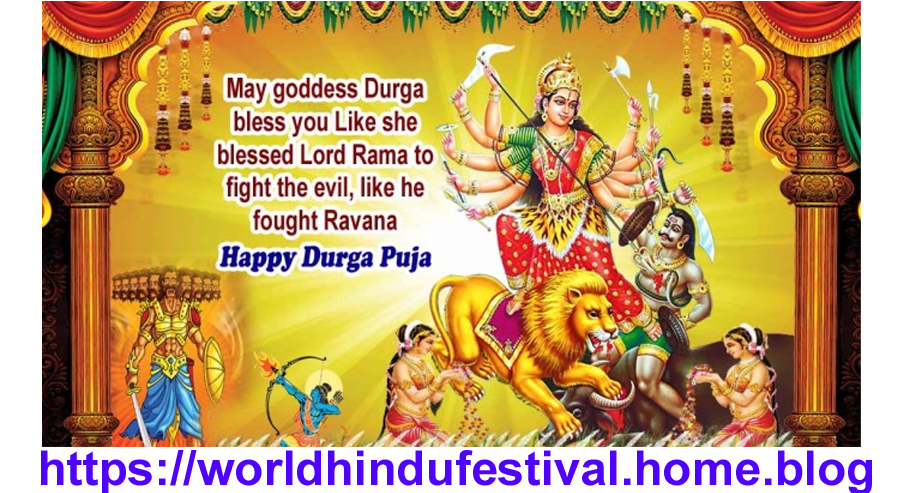CONTENTS:
1) Important Dates of Durgaa Puja
Durgaa Puja Calendar (2008 to 2024)
2) About Goddess Durgaa
3) Origin of Durgaa – The Mythology
4) Different Forms of Durgaa
5) Different Kinds of Durgaa Puja
6) Durgaa Puja in Kolkata
7) The Essentials of Durgaa Puja
8) NAVARAATHRI
9) MAHALAYA
10) DUSSEHRA
11) 108 Names of Durgaa
12) Durgaa Chalisa
13) Nine Days of NAVARAATHRI
14) Navaraathri Songs
15) Mata Temples in India
16) The Rituals of Durgaa Puja
17) Durgaa Puja Recipes
18) Navaraathri Recipes
19) Regional Names of Durgaa Puja
20) Durgaa Stuti Path
21) Durgaa Kavach
22) Durgaa Puja Fast
23) Tradition of Durgaa Puja
24) Significance of Durgaa Puja
25) Durgaa Aarthi
26) Goddess Durgaa Bhajans
Durgaa Puja is one of the religious festivals of India which is celebrated throughout the country with great zeal and fervour. It is particularly celebrated in the state of West Bengal in Kolkata in the honour of celebrating the unfathomable power of Goddess Durgaa. This festival is celebrated during the span of whole period of Navaraathri for a time span of 10 days. From the sixth day of Navaraathri till the ninth day the huge pandaals of the Goddess Durgaa are open for the visitors. The tenth day of the Navaraathri is called as Dashami and on this day the idols of the Goddess Durgaa are immersed into water and this process is called as Visarjan.
Contd…
Telegram provides unlimited cloud storage. This means all your text messages, images media files & documents will be saved on their cloud without losing any data, you don’t need to worry about backup & restore. Telegram Private Groups cannot be found with an in-app search. The group is private, after all that you can use the 2,00,000 member limit fully. Telegram Channels are a tool for broadcasting public (or) private messages to large audiences, similarly as you do on Twitter or Facebook Page. In fact, channels can have an unlimited number of subscribers. Telegram Private Channels cannot be found with an in-app search. Group video calls on Telegram allow 30 users to broadcast from their camera as well as their screens. This can now be watched by 1,000 people at once (updated by 1st August 2021). Users can hold anything event online, from lectures to concerts and everything in between, similarly as Zoom or Microsoft Teams or Google Meet.
Join Us
| Telegram Channel | Twitter | LinkedIn Page | Microsoft Teams | Other Social | WhatsApp Channel | Blogger |
1) Important Dates of Durgaa Puja
Durgaa Puja is celebrated on the last day of Navaraathri. The festival begins on Shasthi and ends on Dashami when the idol of Maa Durgaa is immerged into the rivers or any other water bodies for showing her respect and devotion.
Durgaa Puja: This year, the festival will be celebrated from 6th Day to 10th Day.
Mahalaya: It will be celebrated on 1st Day. This is also one of an important dates of Durgaa Puja when people invite Goddess Durgaa on the Earth and on her idol, eye are drawn.
The celebration of the Durgaa Puja festival occurs during five consecutive days that includes “Saptami”, “Shasthi”, “Ashtami”, “Navami” and “Dashami”.
Shasthi: 6th Day
On this day, it is belived that Goddess Durgaa descends on the earth with her four children including Ganesha, Kartikeya, Lakshami and Saraswathi. And, overwhelmingly on this day, the beautiful idols of Maa Durgaa are opened for people to look through.
Saptami: 7th Day
On this day, Goddess Durgaa idol is said to have invoked with life by the ritual of Pran Pratisthan. A Banana tree is made to get dressed in a sari and bathed in a river like a newly wedded bride and the thi process is called as “Kola Bou”. This is used to transport the energy of Goddess Durgaa.
Ashtami: 8th Day
On this day, Goddess Durgaa is worshipped as a young and virgin girl in a ritual called as Kumari Puja. Sandhi Puja is performed in the evening to worship the Chamunda form of Goddess Durgaa who is supposed to have slayed buffalo demon Mahisasur. The Puja on this day generally takes place at the time when the killing of Mahisasur took place.
Navami: 9th Day
This is the last day of the festival when a Maha Aarathi is organised to mark the conclusion of the festival. Everyone wears new clothes and gets revelled in the festival celebration to the fullest.
Dashami: 10th Day
On this day the idols of Maa Durgaa are moved from its place for immersion into the river and she is believed to return to the abode of her husband. After the process of immersion is over, people enjoy delicious dinner and sweets.
Durgaa Puja Calendar
2024
Mahalaya – 17th September to 2nd October
Maha Panchami – 8th October
Maha Sashthi – 9th October
Maha Saptami – 10th October
Maha Ashtami – 11th October
Maha Navami – 11th October
Vijaya Dashami – 12th October
2023
Mahalaya – 14th October
Maha Panchami – 19th October
Maha Sashthi – 20th October
Maha Saptami – 21st October
Maha Ashtami – 22nd October
Maha Navami – 23rd October
Vijaya Dashami – 24th October
2022
Mahalaya – 25th September
Maha Panchami – 1st October
Maha Sashthi – 1st October
Maha Saptami – 2nd October
Maha Ashtami – 3rd October
Maha Navami – 4th October
Vijaya Dashami – 5th October
2021
Mahalaya – 6th October
Maha Panchami – 10th October
Maha Sashthi – 11th October
Maha Saptami – 12th October
Maha Ashtami – 13th October
Maha Navami – 14th October
Vijaya Dashami – 15th October
2020
Mahalaya – 17th September
Maha Shashthi – 22nd October
Maha Saptami – 23rd October
Maha Ashtami – 24th October
Maha Navami – 25th October
Vijaya Dashami – 26th October
2019
Mahalaya – 28th September
Maha Shashthi – 4th October
Maha Saptami – 5th October
Maha Ashtami – 6th October
Maha Navami – 7th October
Maha Dashami – 8th October
2018
Mahalaya – 8th October
Maha Sashti – 15th October
Maha Saptami – 16th October
Maha Ashtami – 17th October
Maha Navami – 18th October
Vijaya Dashami – 19th October
2017
Mahalaya – 19th September
Maha Sashti – 26th September
Maha Saptami – 27th September
Maha Ashtami – 28th September
Maha Navami – 29th September
Vijaya Dashami – 30th September
2016
Mahalaya – 30th September
Maha Saptami – 8th October
Maha Ashtami – 9th October
Maha Navami – 10th October
Vijaya Dashami – 11th October
2015
Mahalaya – 12th October
Maha Saptami – 20th October
Maha Ashtami – 21st October
Maha Navami – 22nd October
Vijaya Dashami – 23rd October
2014
Mahalaya – 23rd September
Maha Saptami – 1st October
Maha Ashtami – 2nd October
Maha Navami – 3rd October
Vijaya Dashami – 4th October
2013
Mahalaya – 4th October
Maha Saptami – 11th October
Maha Ashtami – 12th October
Maha Navami – 13th October
Vijaya Dashami – 14th October
2012
Mahalaya – 15th October
Maha Saptami – 21st October
Maha Ashtami – 22nd October
Maha Navami – 23rd October
Vijaya Dashami – 24th October
2011
Mahalaya – 27th September
Maha Saptami – 3rd October
Maha Ashtami – 4th October
Maha Navami – 5th October
Vijaya Dashami – 6th October
2010
Mahalaya – 7th October
Maha Saptami – 14th October
Maha Ashtami – 15th October
Maha Navami – 16th October
Vijaya Dashami – 17th October
2009
Mahalaya – 18th September
Maha Saptami – 25th September
Maha Ashtami – 28th September
Maha Navami – 27th September
Vijaya Dashami – 28th September
2008
Mahalaya – 28th September
Maha Saptami – 6th October
Maha Ashtami – 7th October
Maha Navami – 8th October
Vijaya Dashami – 9th October
Video # 1 : May the Divine Shakthi be with you Dusshera season
Telegram Channel: Join at World Hindu & Health Instruction (@WorldHinduHealth)[ https://t.me/WorldHinduHealth ]
World Hindu & Health Instruction : Index – Videos List
A. Simple: Telegram is so simple you already know how to use it.
B. Private: Telegram messages are heavily encrypted and can self-destruct.
C. Synced: Telegram lets you access your chats from multiple devices.
D. Fast: Telegram delivers messages faster than any other application such WhatsApp, Signal etc.
E. Powerful: Telegram has no limits on the size of your media and chats.
F. Open: Telegram has an open API and source code free for everyone.
G. Secure: Telegram keeps your messages safe from hacker attacks.
H. Expressive: Telegram lets you completely customise your messenger.
Join Us
| Telegram Channel | Twitter | LinkedIn Page | Microsoft Teams | Other Social | WhatsApp Channel | Blogger |
2) About Goddess Durgaa
Durgaa, in Sanskrit means “She who is incomprehensible or difficult to reach.” Goddess Durgaa is a form of Sakthi worshiped for her gracious as well as terrifying aspect. Mother of the Universe, she represents the infinite power of the universe and is a symbol of a female dynamism. The manifestation of Goddess Durgaa is said to emerge from Her formless essence and the two are inseparable.
She is also called by many other names, such as Parvathi, Ambika, and Kali. In the form of Parvathi, She is known as the divine spouse of Lord Shiva and is the mother of Her two sons, Ganesha and Karththikeya, and daughter Jyothi. Destroyer of demons, she is worshiped during an annual festival called Durgaa puja, especially popular among Bengali’s.
Her Appearance
There are endless aspects of Durgaa described in the Puranas and Agamas and the iconography is consequently very varied. She is usually pictured as having ten arms holding Sword, Conch, Discus, Rosary, Bell, Winecup, Shielf, Bow, Arrow, and Spear. She is most often shown riding a lion from which comes Her august name, Simhavahini, “She who stands astride the king of beasts”. She is gorgeously dressed in royal red cloth and has several ornaments decorating Her personage. Her hair is dressed up in a crown (karandamukuta) which then flows out in long luxuriant tresses that are darkly luminous and soothing to the eye. The various tools reflects the eminent supremacy that helps in controlling the universe and obey Her will.
Weilding Energy
Goddess Durgaa exists eternally, always abiding in her own sweet nature and inhabits the hearts and minds of her ecstatic devotees. As Sakthi power, she shapes, nurtures, and dissolves names and forms, while as subtle spiritual energy called Kundalini, She lights the lotuses of the seven centres of awareness in the sacred human body. Goddess Durgaa killed the powerful demon Mahish and all his great commanders. When demonic forces create imbalance all god unite becoming one divine force called Sakthi or Durgaa.
Video # 2 Significance of Dusshera
Telegram Channel: Join at World Hindu & Health Instruction (@WorldHinduHealth)
[ https://t.me/WorldHinduHealth ]
World Hindu & Health Instruction : Index – Videos List
Contd…
Join Us
| Telegram Channel | Twitter | LinkedIn Page | Microsoft Teams | Other Social | WhatsApp Channel | Blogger |
3) Origin of Durgaa – The Mythology
Devi is the great goddess of the Hindus, the consort of Shiva and she is worshiped in various forms corresponding to her two aspects: benevolence and fierceness. She is Uma, “light”; Gauri, “yellow or brilliant”; Parvathi, “the mountaineer”; and Jagatmata, “the-mother-of-the-world” in her milder guise. The terrible emanations are Durgaa “the inaccessible”; Kali, “the black”; Chandi, “the fierce”; and Bhairavi, “the terrible.”
Descent of the Goddess
Durgaa, a beautiful warrior seated upon a tiger, was the first appearance of the great goddess. The circumstance of her miraculous arrival was the tyranny of the monster-demon Mahishasur, who through terrific austerities had acquired invincible strength. The gods were afraid of this water-buffalo bull because neither Vishnu nor Shiva could prevail against him. It seemed that the joint energy of Shakthi was only capable of vanquishing Mahisha, and so it was the eighteen-armed Durgaa who went out to do battle.
Battlefield
She went to battle on her ferocious mount lion, armed with the weapons given to her by the other Gods. Durgaa is one of the angry and aggressive aspects of the goddess Shakthi, whose role in Hindu mythology was to fight and conquer demons and also personify the Sakthi or female aspect of any male deity. In the battle, she fought and killed the evil Mahishasura and restored heaven to the Gods. Since then the goddess is invoked for protection from the powers of evil. Durgaa Puja is observed in her honor, to celebrate her victory over evil.
Revered Mother
She has been worshiped from about 400 AD, but probably earlier, to the present. Her literary references are chiefly the Ramayana and Mahabharata, epic and Puranic texts, and she is mentioned by name in Vedic literature. In general, Durgaa is regarded in northern India as the gentle bride epitomising family unity while in southern India she is revered more in her warrior aspect.
Video # 3 : Why is Goddess Lakshmi Always Restless
Telegram Channel: Join at World Hindu & Health Instruction (@WorldHinduHealth)
[ https://t.me/WorldHinduHealth ]
World Hindu & Health Instruction : Index – Videos List
Contd…
Join Us
| Telegram Channel | Twitter | LinkedIn Page | Microsoft Teams | Other Social | WhatsApp Channel | Blogger |
4) Different Forms of Durgaa
As the ten-armed Goddess, Goddess Durgaa presents a radiantly beautiful form that is bewitching to behold. That special form is somehow simultaneously wrathful and benign and transmits profound spiritual teachings in an exacting manner. The nine-day period from the new moon day to the ninth day of Ashvina is considered the most auspicious time of the Hindu Calendar and is hence the most celebrated time of the year as Durgaa Puja. The nine different forms of Devi are worshiped over the nine days. These are the most popular forms under which she is worshiped:
Durgaa Shailputhri (Daughter of Mountain)
She is a daughter of Himalaya and first among nine Durgaas. In previous birth she was the daughter of Daksha. Her name was Sathi – Bhavani. i.e. the wife of Lord Shiva. Once Daksha had organised a big Yagna and did not invite Shiva. But Sathi being obstinate, reached there. Thereupon Daksha insulted Shiva. Sathi could not tolerate the insult of husband and burnt herself in the fire of Yagna. In other birth she became the daughter of Himalaya in the name of Parvathi – Hemvathi and got married with Shiva. As per Upnishad she had torn and the egotism of Indra, etc. Devtas. Being ashamed they bowed and prayed that, “In fact, thou are Shakthi, we all – Brahma, Vishnu and Shiv are capable by getting Shakthi from you.”
1 Day – Goddess Durgaa Shailputhri
Brahmacharini
The second Durgaa Sakthi is Brahamcharini. Brahma that is who observes penance(tapa) and good conduct. Here “Brahma” means “Tapa”. The idol of this Goddess is very gorgeous. There is rosary in her right hand and Kamandal in left hand. She is full with merriment. One story is famous about her. In previous birth she was Parvathi Hemavathi the daughter of Himvan. Once when she was busy in games with her friends. Naradaji came to her and predicted seeing her Palm-lines that, “You will get married with a naked-terrible ‘Bhole baba’ who was with you in the form of Sathi, the daughter of Daksha in previous birth. But now you have to perform penance for him.” There upon Parvathi told her mother Menaka that she would marry none except Shambhu, otherwise she would remain unmarried. Saying this she went to observe penance. That is why her name is famous as tapacharini – Brahmacharini. From that time her name Uma became familiar.
2 Day – Goddess Brahmacharini
Chandraghanta
The name of third Sakthi is Chandraghanta. There is a half-circular moon in her forehead. She is charmful and bright. She is Golden color. She has three eyes and ten hands holding with ten types of swords – etc. weapons and arrows etc. She is seated on Lion and ready for going in war to fight. She is unprecedented image of bravery. The frightful sound of her bell terrifies all the villains, demons and danavas.
3 Day – Goddess Chandraghanta
Kushmanda
Name of fourth Durgaa is Kushmanda. The Sakthi creates egg, i.e. Universe by mere laughing. She resides in solar systems. She shines brightly in all the ten directions like Sun. She has eight hands. Seven types of weapons are shining in her seven hands. Rosary is in her right hand. She seems brilliant riding on Lion. She likes the offerings of “Kumhde.” Therefore her name “Kushmanda” has become famous.
4 Day – Goddess Kushmanda
Skanda Mata
Fifth name of Durgaa is “Skanda Mata”. The daughter of Himalaya, after observing penance got married with Shiva. She had a son named “Skanda.” Skanda is a leader of the army of Gods. Skanda Mata is a deity of fire. Skanda is seated in her lap. She has three eyes and four hands. She is white and seated on a lotus.
5 Day – Goddess Skandamata
Kathyayani
The son of “Kat” as “Katya”. Rishi Katyayan born in this “Katya” lineage. Kathyayan had observed penance with a desire to get paramba as his daughter. As a result she took birth as a daughter of Kathyayan. Therefore her name is “Kathyayani” . She has three eyes and eight hands. These are eight types of weapons missiles in her seven hands. Her vehicle is Lion.
6 Day – Goddess Kathyayani
Contd…

Join Us
| Telegram Channel | Twitter | LinkedIn Page | Microsoft Teams | Other Social | WhatsApp Channel | Blogger |
Kaalaraathri
Seventh Durgaa is Kaalaraathri She is black like night. Durgaa hairs are unlocked. She has put on necklaces shining like lightening. She has three eyes which are round like universe. Her eyes are bright. Thousands of flames of fire come out while respiring from nose. She rides on Shava (dead body). There is sharp sword in her right hand. Her lower hand is in blessing mood. The burning torch (mashal) is in her left hand and her lower left hand is in fearless style, by which she makes her devotees fearless. Being auspicious she is called “Shubhamkari.”
7 Day – Goddess Kaalaraathri
Maha Gauri
The Eighth Durgaa is “Maha Gauri.” She is as white as a conch, moon and Jasmine. She is of eight years old. Her clothes and ornaments are white and clean. She has three eyes. She rides on bull She has four hands. The above left hand is in “Fearless – Mudra” and lower left hand holds “Trishul.” The above right hand has tambourine and lower right hand is in blessing style. She is calm and peaceful and exists in peaceful style. It is said that when the body of Gauri became dirty due to dust and earth while observing penance, Shiva makes it clean with the waters of Gangas. Then her body became bright like lightening. There fore, she is known as “Maha Gauri” .
8 Day – Goddess Mahagauri
Siddhidathri
Ninth Durgaa us Siddhidathri. There are eight Siddhis , they are- Anima, Mahima, Garima, Laghima, Prapti, Prakamya, Iishitva & Vashitva. Maha Shakthi gives all these Siddhies. It is said in “Devipuran” that the Supreme God Shiv got all these Siddhies by worshipping Maha Shakthi. With her gratitude the half body of Shiv has became of Goddess and there fore his name “Ardhanarishvar” has became famous. The Goddess drives on Lion. She has four hands and looks pleased. This form of Durgaa is worshiped by all Gods, Rishis-Munis, Siddhas, Yogis, Sadhakas and devotees for attaining the best religious asset.
9 Day – Goddess Siddhidathri
Telegram Channel: Join at World Hindu & Health Instruction (@WorldHinduHealth)
[ https://t.me/WorldHinduHealth ]
World Hindu & Health Instruction : Index – Videos List
Contd…
Telegram
Telegram is one of the World Famous Social Networking Site & App and Social Media Chat Messaging, one of the Strongest competitor and Whole Feature powerful.

Telegram is better than WhatsApp, Google Hangouts, BlackBerry Messenger, Hike Messenger, Facebook Messenger.
Join Us
| Telegram Channel | Twitter | LinkedIn Page | Microsoft Teams | Other Social | WhatsApp Channel | Blogger |
5) Different Kinds of Durgaa Puja
Durgaa-puja, over the years, has outgrown its religious connotations to a large extent as people all over the India celebrate it with a gusto. There are various ways in which Ma Durgaa is worshiped. The rituals and customs vary due to vast difference in the culture of Indian States. But, all these follow the century old tradition and practice that intermingle with historical ethos.
Maharashtra
In Maharashtra, Durgaa Puja is a fun occasion. Puja is performed each day and devotees don’t remove the flower garland that is put each day on the idol or image of the deity. After nine days all nine are removed together. Young girls who have not attained maturity are invited to eat, play games, dance and sing. An elephant is drawn with rangoli and the girls play guessing games. Then they are fed a meal of their choice.
West Bengal
In West Bengal, Durgaa Puja is five days of festivity. It hinges around Mahalaya day, a week before the actual celebrations begin. It was on this day that Durgaa was assigned the task of eliminating evil. So the familiar pose of Durgaa unleashing her wrath on an out powered assura (demon). Legend goes that Raam wanted to invoke the blessings of Durgaa before his great war with Raavan. He performed the Durgaa Puja despite the time of year not being right. That is why the puja is also known as Akal Bodhon, or untimely invocation. .
Punjab
People of Punjab strictly observes Navaraathri. Some Punjabus have only milk for seven days before breaking the fast on ashthami or navami. They worship Durgaa Ma and do the aarthi at home. Some of them have fruit or a complete meal once a day and intoxicating drinks or meat and other form of entertainment is completely avoided. At the end of the fast devotees feed beggars or worship little girls who spell the Shakthi of the Mother Goddess.
Gujarat
Navaraathri is devoted to Amba mataji. In some homes, images of mataji are worshiped in accordance with accepted practice. This is also true of the temples, which usually have a constant stream of visitors from morning to night. The most common form of public celebration is the performance of garba or dandia-ras, Gujarat’s popular folk-dance, late throughout the nights of these nine days in public squares, open grounds and streets.
Kerala
In Kerala, Durgaa Puja signifies the beginning of formal education for every child aged 3-5 years. While puja goes on in the temple for all ten days, it is only the concluding three days which are really important. Ashthami is the day of Ayudya Puja, when all the tools at home are worshiped. Custom dictates that no tools be used on this day. On navami, day, Goddess Saraswathi is honored by worshiping the books and records at home.
Thousands throng the Saraswathi temple at Kottayam during this period to take a dip in the mysterious holy pond whose source is yet unknown. Large gatherings are also seen at the famous temples at Thekkegram (Palghat), in which there are no idols — only huge mirrors. A devotee finds himself bowing before his own reflection which indicates that God is within us.
Kashmir
Hindus are a minority in Jammu and Kashmir but they celebrate their festivals with pomp and show. These days, festivities are subdued, though. The favorite deities of Kashmir are Lord Shiva and Serawali Ma Durgaa, the one who rides the tiger. Pundits and Muslims alike vouch that Navaraathri is important. No big pandals here, each Hindi house-hold does the puja at home. All the adult members of the household fast on water. In the evenings, fruit may be taken. As elsewhere, Kashmiris grow barley in earthen pots. They believe that if the growth in this pot is good, there is prosperity all year.
The most important ritual for Kashmiri Pandits is to visit the temple of guardian goddess Kheer Bhavani on all nine days. On the last day of Navaraathri, an aarthi is held at the temple after which people break their fast. On Dussehra day, Raavana’s effigy is burnt. Devotees also visit the Hari Parbat temple.
Telegram Channel: Join at World Hindu & Health Instruction (@WorldHinduHealth)
[ https://t.me/WorldHinduHealth ]
World Hindu & Health Instruction : Index – Videos List
Contd…
Telegram

NOTE: Microsoft Kaizala has retired on 31st August 2023. Kaizala moved to Microsoft Teams from 1st September 2023.
6) Durgaa Puja in Kolkata
Durgaa Puja the biggest festival of Bengalis is also considered as one of the social events of India. It is an auspicious festival of Bengalis which is also referred as a 10 days of carnival in the state of West Bengal and eastern state of India. In Kolkata the capital city of West Bengal and other neighboring states, magnificently created puja pandals are erected and are major attraction. Magnificent Puja Pandals are unique in terms of their materials, theme and shapes. It is truly a delight for eyes to watch such magnificent Pandals of Durgaa Puja and amazingly carved goddess idols. For complete 10 days of celebration, a spurt of fanfare is easily sensed and that too especially on last 5 days of the festival. Bengalis consider Durgaa Puja as a wonderful festival celebration to reconnect with family and friends. In fact the air gets filled with the festivity during this time of the year. Read further to know more about Durgaa Puja in Kolkata.
Durgaa Puja Celebrations in Kolkata
Preparations for Durgaa Puja Fest
Durgaa Puja festival preparations commences one or two months in prior to the celebration dates. Just like Diwali bonus offered to employees in North India, in Kolkata Puja Bonus is offered to employees of both government as well as private organisations. In fact, many Pre-puja bargain sales are also offered by shops in Kolkata as they get huge amount of sale during the festival. The festival is in fact welcomed with great enthusiasm by every household.
The Making of Durgaa Idol
Many years back, Durgaa Puja festival was celebrated within the families at home and now it has turned into a community festival which is celebrated at Puja pandals. Few months prior to the festival celebration in Kumartuli which is a place near to Kolkata, amazing idols of goddess Durgaa are given shape. It is a famous place for production of beautiful idols of gods and goddesses. Here the expert artisans show their talent in making idols of Goddess Durgaa, Lord Karthik, Goddess Saraswathi, Lord Ganesha, Goddess Lakshmi and the demon Mahisasura which are required for the festival.
Magnificient Decorations of Durgaa Puja Pandal
On Durgaa Puja, puja pandals are the main attraction. Many people are much talented in developing Puja Pandals (huge covered stage for Puja) with use of wood, paper, bamboos, plastic materials, clothes and other amazing stuffs. Innovative ideas of making Pandal set ups and goddess idols are done with great devotion and a lot of money is erected in Puja Pandals which are all decked with mesmerising art work. In fact many pandals are also built in shape of world famous monuments or structures.
Durgaa Puja Celebration & its Main Days
The major days of the celebration of Durgaa Puja celebration are seventh, eight, ninth and the tenth day. Basically, the celebration of Durgaa Puja gears its pace on the 6th day of celebration that is on Maha Shashthi. The major rituals of Durgaa Puja start on the 7th day. The priest is called upon to chant the mantras, shlokas of Puja and perform aarthi at the pandal of the Puja. Moreover, there are many cultural activities held such as dance and song competitions as well as games are also organised during last few days of the festival celebration. Many professional artists like singers, dancers, musicians are also called for singing bhajan and stuti of Goddess Durgaa. Apart from pandal decorations, the city is also illuminated and decorated with displays of colorful and sparkling lights. Also educational institutions as well as offices are closed during four main days of Durgaa Puja celebration. Indeed, Durgaa Puja is the biggest nd most cheerfully celebrated festival of Kolkata.
Telegram Channel: Join at World Hindu & Health Instruction (@WorldHinduHealth)
[ https://t.me/WorldHinduHealth ]
World Hindu & Health Instruction : Index – Videos List
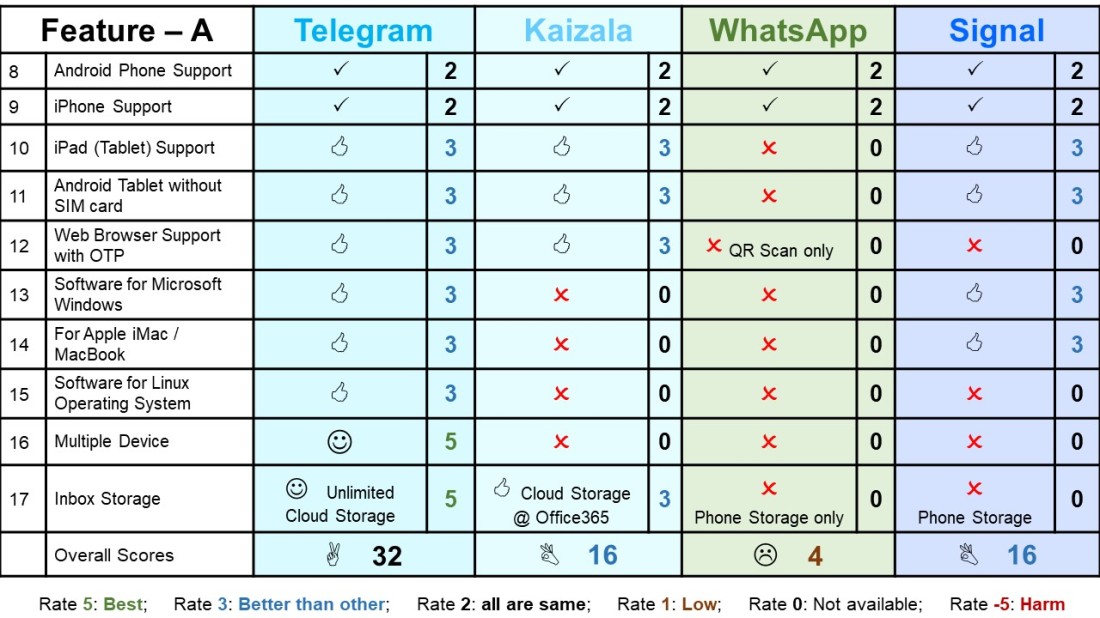
NOTE: Microsoft Kaizala has retired on 31st August 2023. Kaizala moved to Microsoft Teams from 1st September 2023.
7) The Essentials of Durgaa Puja
Specific items are needed for each day of Durgaa Puja. There is a detailed method to worshiping Goddess Durgaa that are mentioned in the scriptures. Items which are needed for the ritual worship of the goddess should be collected beforehand so that the ritual is performed smoothly. The list of essentials of Durgaa Puja are:
Items needed for Kalparambho, the ritual performed before the commencement of the puja and Mahasna:
Food Offerings : Panchashasha (grains of five types – rice, mung or whole green gram, til or sesame, mashkalai or any variety of whole black leguminous seed, job or millet), panchagobbo (five items obtained from the cow – milk, ghee or clarified butter, curd, cow dung and gomutra ), curd, honey, sugar, three big noibiddos , one small noibiddo, three bowls of madhupakka (a mixture of honey, curd, ghee and sugar for oblation), bhoger drobbadi (items for the feast), aaratir drobbadi mahasnan oil, dantokashtho, sugar cane juice, an earthen bowl of atop (a type of rice), til toilo (sesame oil).
Water Offerings: Ushnodok (lukewarm water), coconut water, sarbooushodhi , mahaoushodhi, water from oceans, rain water, spring water, water containing lotus pollen.
Puja Items: Sindur (vermillion), panchabarner guri (powders of five different colours – turmeric, rice, kusum flowers or red aabir, rice chaff or coconut fibre burnt for the dark colour, bel patra or powdered wood apple leaves), panchapallab (leaves of five trees – mango, pakur or a species of fig, banyan, betal and Joggodumur or fig), pancha ratna (five types of gems – gold, diamond, sapphire, ruby and pearl), panchakoshay (bark of five trees – jaam, shimul, berela, kool, bokul powdered in equal portions and mixed with water), green coconut with stalk, three aashonanguriuk (finger ring made of kusha).
Cloth Offerings: Gamcha or a piece of cloth to cover the pot, a dhoti for Vishnu, a sari each for bodhon and Chandi.
Decorative Items : Ghat or a pot, kundohari , a mirror, four arrows, tekatha or a triangular frame of wood, horitoki flowers (myrobalan), chandmala (garland with circular decorations), aashon (a mattress of jute or hay).
Other Items : Water camphor and perfumed sandal wood paste. soil – extracted from elephant tusks, from the teeth of the pig, from the horns of the ox, from the bank of rivers Ganga and Saraswathi, from both the banks of a river, from a place where four roads intersect, from palaces, from the ant hill, from the mountains, Vishnu toilo.
Items needed for the Shashthi puja of Goddess Durgaa:
Food Offerings: A stem of wood apple with fruits, green coconut with stalk, an earthen bowl full of atop, three bowls of madhupakka, sesame seeds, curd, honey, clarified butter, sugar, three big noibiddos, one small noibiddo, bhoger drobbadi, aarathir drobbadi, grain, fruits, one dozen bananas with a single stem, white mustard seeds.
Puja Items : A pot, four arrows two ashonanguriuk, panchapallab, pancha ratna, panchashasha, panchagobbo, tekatha, dubba grass, sindur, swastik pituli, conch shell, kajol (corrilium), gorachana, yellow thread, chamor, a fly-whisk made of yak’s tail used for fanning, earthen lamps, panch pradip for arathi.
Cloth Offerings: Gamcha to cover the pot, a dhoti for the wood apple tree, a sari for bodhon, one sari for amontron.
Decorative Items: Myrobalan, flowers, chandmala, adibas oil, turmeric, soil from the bank of river Ganga, perfume, stone, gold, silver, copper, iron, mirror and alta.
Items Needed For Sapthami Puja of Goddess Durgaa:
Food Offerings: Sesame seeds, myrobalan, flowers, two earthen bowls full of atop, green coconut with stalk, wood apple leaves, white mustard, madhupakka (40 or 22 bowls), honey, sugar, noibiddos (40 or 22), one main noibiddo, fruits, items for bhog.
Puja Items: Jute ropes, red thread, alta, four finger rings, four yadnyopaveet, a pot, a mirror, a tekatha, sandalwood, mashkolai, hibiscus flower, small noibiddo, one big earthen lamp, panchapallab, pancha ratna, panchashasha, panchaguri, vermillion, items for arati, items for the yadnya – sand, wood, dry khorke grass, cowdung, kusha grass, ghee, 108 bel leaves and a bowl.
Cloth Offerings: Clothes for the Pundit, a piece of cloth, gamcha for arathi, 40 or 22 finger rings made of kusha, sari for nabapatrika, one sari for the main puja, saris for Durgaa, Lakshmi, Saraswathi, Chandi, dhoti for Karthik, Ganesh, Shiva, Vishnu, clothes for nine planets, clothes for peacock, mouse, lion, demon, buffalo, ox, snake, chandmala, a nosering, iron, conch shell.
Plants and flowers offerings: Flower garland, belpatra garland, Banana plant, turmeric plant, colacassia plant, wood apple stem, pomegranate stem, a stem of Jayanthi plant, arum plant, rice plant, ashoka stem, twigs of white aparajita plant, two banana stems.
Items needed for Ashthami Puja of Goddess Durgaa:
Food Offerings : Fruits, items for bhog, items for arathi, 40 or 22 bowls of madhupakka, honey, sugar, curd, ghee, 40 or 22 noibiddos, four small noibiddos.
Cloth Offerings : One sari for Durgaa, new clothes for Lakshmi, Saraswathi, Chandi, Karthik, Ganesh, Shiva, Vishnu, nine planets, the peacock, mouse, lion, demon, buffalo, ox, snake, Jaya, Bijoya and Ram.
Puja Items : One dantakashto, 40 or 22 finger rings made of kusha, one nosering, iron, two conch shells, a box of vermillion, flowers, a garland, belpatra garland, one chandmala, one ghoti.
For Sandhi Puja – Flowers, gold ring, a bronze bowl for madhupakka, a small sari, main noibiddo, one small noibiddo, one plate, one pitcher, iron, one nosering, one pillow, a mat, a chandmala, 108 earthen lamps, items for bhog, and items for the arati .
Items needed for Nabami and Dashami Pujas:
Food Offerings : Betel leaves, pan masala, 40 or 22 bowls of madhupakka, honey, sugar, curd, ghee, 40 or 22 noibiddos, four small noibiddos.
Cloth Offerings : Clothes for Lakshmi, Saraswathi, Chandi, Karthik, Ganesh, Shiva, Vishnu, the nine planets, the peacock, mouse, lion, demon, buffalo, ox, snake, Jaya, Bijoya and Ram, one dantakashto , one sari for the main puja.
Puja Items: Flowers, 40 or 22 finger rings made of kusha, one ghoti , one nosering, iron, two conch shells, a box of vermillion, flower garland, belpatra garland, a chandmala, one plate, items needed for the yadnya (fire sacrifice), bel leaves, gift for the Purohith.
For the Dashami puja – Perfume, flowers, durba grass, basil leaves, bel leaves, incense sticks, an earthen lamp, noibiddo, curd, murki, sweets and items needed for arathi.
Telegram Channel: Join at World Hindu & Health Instruction (@WorldHinduHealth)
[ https://t.me/WorldHinduHealth ]
World Hindu & Health Instruction : Index – Videos List

NOTE: Microsoft Kaizala has retired on 31st August 2023. Kaizala moved to Microsoft Teams from 1st September 2023.
8) NAVARAATHRI
Navaraathri, the festival of nights, lasts for 9 days with three days each devoted to worship of Ma Durgaa, the Goddess of Valor, Maa Lakshmi, the Goddess of Wealth and Maa Saraswathi, the Goddess of Knowledge. During the nine days of Navaraathri, feasting and fasting take precedence over all normal daily activities amongst the Hindus. Evenings give rise to the religious dances in order to worship Goddess Durgaa Maa.
1st – 3rd day of Navaraathri
On the first day of the Navaraathras, a small bed of mud is prepared in the puja room of the house and barley seeds are sown on it. On the tenth day, the shoots are about 3 – 5 inches in length. After the puja, these seedlings are pulled out and given to devotees as a blessing from god. These initial days are dedicated to Durgaa Maa, the Goddess of power and energy. Her various manifestations, Kumari, Parvathi and Kali are all worshipped during these days. They represent the three different classes of womanhood that include the child, the young girl and the mature woman.
4th – 6th day of Navaraathri
During these days, Lakshmi Maa, the Goddess of peace and prosperity is worshipped. On the fifth day which is known as Lalitha Panchami, it is traditional, to gather and display all literature available in the house, light a lamp or ‘diya’ to invoke Saraswathi Maa, the Goddess of knowledge and art.
7th – 8th day of Navaraathri
These final days belong to Saraswathi Maa who is worshipped to acquire the spiritual knowledge. This in turn will free us from all earthly bondage. But on the 8th day of this colourful festival, yagna (holy fire) is performed. Ghee (clarified butter), kheer (rice pudding) and sesame seeds form the holy offering to Goddess Durgaa Maa.
Mahanavami
The festival of Naaraathri culminates in Mahanavami. On this day Kanya Puja is performed. Nine young girls representing the nine forms of Goddess Durgaa are worshiped. Their feet are washed as a mark of respect for the Goddess and then they are offered new clothes as gifts by the worshiper. This ritual is performed in most parts of the country.
Telegram Channel: Join at World Hindu & Health Instruction (@WorldHinduHealth)
[ https://t.me/WorldHinduHealth ]
World Hindu & Health Instruction : Index – Videos List
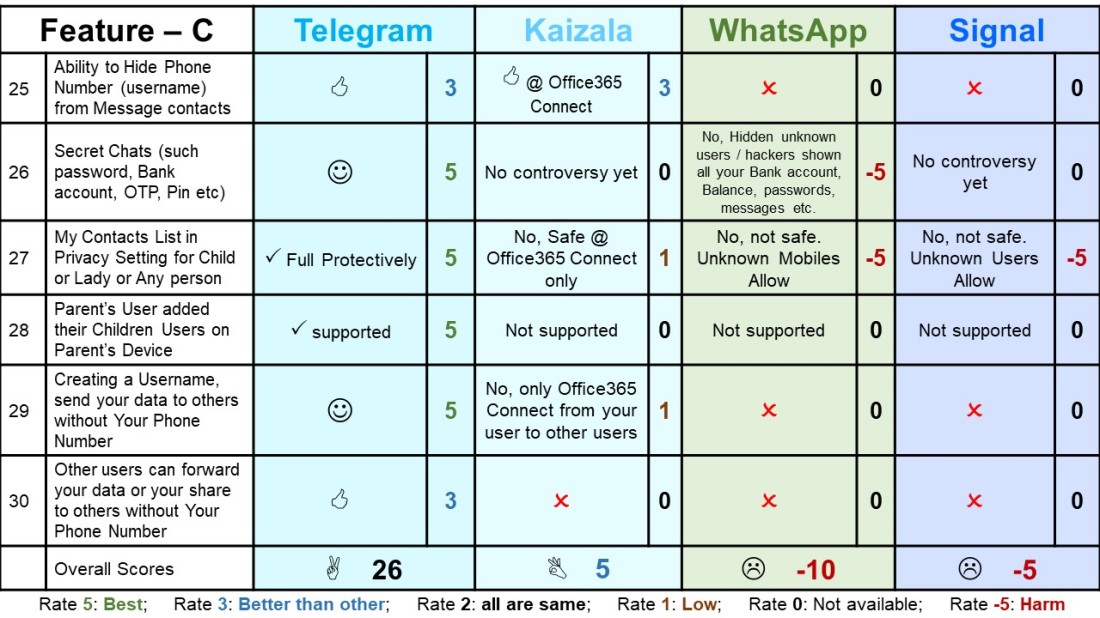
NOTE: Microsoft Kaizala has retired on 31st August 2023. Kaizala moved to Microsoft Teams from 1st September 2023.
9) MAHALAYA
Mahalaya ushers in the aura of Durgaa Puja. The countdown for the Durgaa Puja begins much earlier, from the day of ‘Janmasthami’. It is only from the day of Mahalaya that the preparations for the Durgaa Puja reaches the final stage. The midnight chants of various hymns of ‘Mahishasura Mardini’ reminds one of the beginning of Durgaa Puja.
Mahalaya is an auspicious occasion observed seven days before the Durgaa Puja, and heralds the advent of Durgaa, the goddess of supreme power. It’s a kind of invocation or invitation to the mother goddess to descend on earth – “Jago Tumi Jago”. This is done through the chanting of mantras and singing devotional songs.
The day of Mahalaya is also the day of remembrance. On this day, people offer ‘tarpan’ in memory of their deceased forefathers. The banks of River Ganga becomes a sea of humanity. Priests are seen busy performing ‘Tarpan’ for devotees in groups. The rituals start from early down and end during the midday. Devotees and worshipers buy clothes and sweets to offer to their forefathers. ‘Tarpan’ is to be performed in empty stomach. After offering ‘tarpan’, people eat at the same place.
Telegram Channel: Join at World Hindu & Health Instruction (@WorldHinduHealth)
[ https://t.me/WorldHinduHealth ]
World Hindu & Health Instruction : Index – Videos List
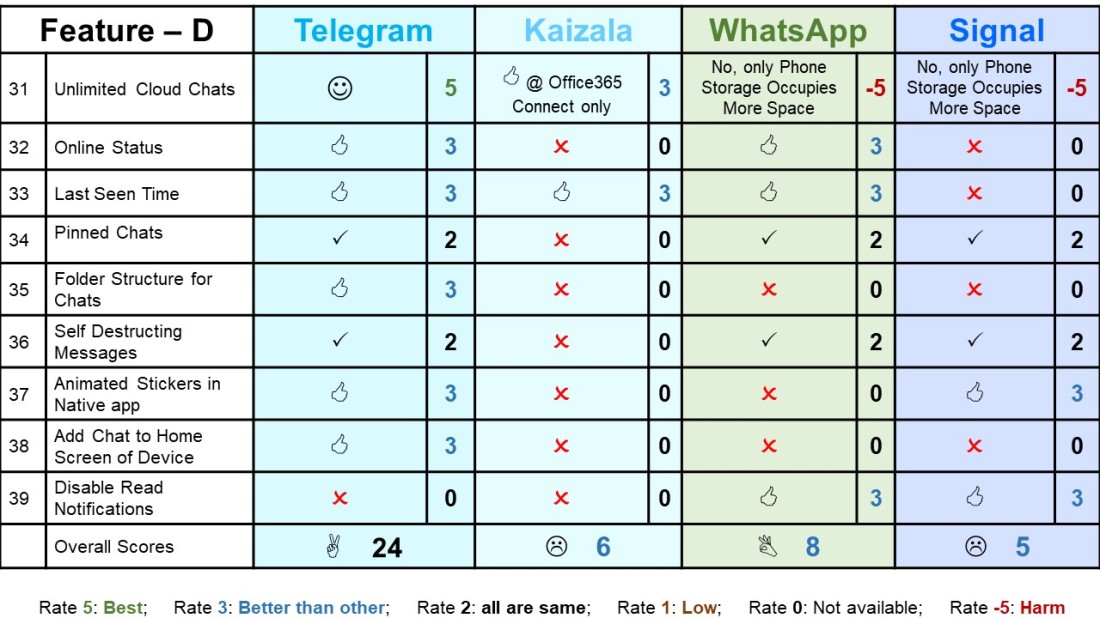
NOTE: Microsoft Kaizala has retired on 31st August 2023. Kaizala moved to Microsoft Teams from 1st September 2023.
10) DUSSEHRA
Dussehra is the last of the day
The festival of Dussehra, also known as Vijayadashmi, is one of the fascinating festivals of India and is celebrated with joy and enthusiasm. According to the great Hindu scripture, the Ramayana, Lord Rama performed chandi-puja (holy prayer). This was carried out in order to invoke the blessings of Durgaa Maa for the killing of Raavana, the ten-headed demon king of Sri Lanka who had abducted Sitha, wife of Lord Raama.
Durgaa Maa divulged the secret to Raama on how he could slay the great Raavana. Hence upon vanquishing the demon Raavana, Lord Rama with Sitha and younger brother Laxmana, returned victorious to his kingdom of Ayodhya on the day which is called ‘Diwali’. Revelers across northern India re-enact the legend at sundown in a performance called the Raamlila, featuring actors dressed as Raama shooting flaming arrows at effigies stuffed with firecrackers.
Dussehra day is considered a most auspicious day. It is a time-honored belief that if any new venture is started on this day, it is bound to be successful. Hence, all the undertakings be it laying-in of foundation of a new building, opening of a new commercial establishment or even initiating a child into the world of learning- are started on this day. Also on this day implements of agriculture, manufacturer’s machines, the intellectuals pens, the household articles, the children’s school books are placed before the idol of Durgaa and worshiped.
Telegram Channel: Join at World Hindu & Health Instruction (@WorldHinduHealth)
[ https://t.me/WorldHinduHealth ]
World Hindu & Health Instruction : Index – Videos List

NOTE: Microsoft Kaizala has retired on 31st August 2023. Kaizala moved to Microsoft Teams from 1st September 2023.
11) 108 Names of Durgaa
|
Name
|
Meaning
|
| Durgaa | The Inaccessible |
| Devi | The Diety |
| Thribhuvaneshwari | Goddess of The Three Worlds |
| Yashodagarba Sambhoota | Emerging From Yashoda’s Womb |
| Narayanavarapriya | Fond of Narayana’s Boons |
| Nandagopakulajata | Daughter Of The Nandagopa Race |
| Mangalya | Auspicious |
| Kulavardhini | Developer Of The Race |
| Kamsavidravanakari | Threatened Kamsa |
| Asurakshayamkari | Reducer Of The Number Of Demons |
| Shilathata Vinikshibda | At Birth,Slammed By Kamsa |
| Akashagamini | Flew In The Sky |
| Vasudevabhagini | Sister Of Vasudeva |
| Divamalya Vibhooshita | Adorned With Beautiful Garlands |
| Divyambaradhara | Beautifully Robed |
| Khadgaketaka Dharini | Holder Of Sword And Shield |
| Shiva | Auspicious |
| Papadharini | Bearer Of Others’ Sins |
| Varada | Granter Of Boons |
| Krishna | Sister Of Krishna |
| Kumari | Young Girl |
| Brahmacharini | Seeker Of Brahman |
| Balarkasadrushakara | Like The Rising Sun |
| Purnachandra Nibhanana | Beautiful Like The Full Moon |
| Chaturbhuja | Four-Armed |
| Chaturvakttra | Four-Faced |
| Peenashroni Payodhara | Large Bosomed |
| Mayoora Pichhavalaya | Wearer Of Peacock-Feathered Bangles |
| Keyurangadadharini | Bejewelled With Armlets And Bracelets |
| Krishnachhavisama | Like Krishna’s Radiance |
| Krishna | Dark-Complexioned |
| Sankarshanasamanana | Equal To Sankarshana |
| Indradhwaja Samabahudharini | With Shoulders Like Indra’s Flag |
| Patradharini | Vessel-Holder |
| Pankajadharini | Lotus-Holder |
| Kanttadhara | Holder of Shiva’s Neck |
| Pashadharini | Holder Of Rope |
| Dhanurdharini | Holder Of Bow |
| Mahachakradharini | Holder Of Chakra |
| Vividayudhadhara | Bearer Of Various Weapons |
| Kundalapurnakarna Vibhooshita | Wearer Of Earrings Covering The Ears |
| Chandravispardimukha | Beautiful Like The Moon |
| Mukutavirajita | Shining With Crown Adorned |
| Shikhipichhadwaja Virajita | Having Peacock-Feathered Flag |
| Kaumaravratadhara | Observer Of Fasts Like Young Girls Do |
| Thridivabhavayirthri | Goddess Of The Three Worlds |
| Thridashapujita | The Goddess Of The Celestials |
| Trailokyarakshini | Protector Of The Three Worlds |
| Mahishasuranashini | Destroyer Of Mahisha |
| Prasanna | Cheerful |
| Surashreshtta | Supreme Among The Celestials |
| Shiva | Shiva’s Half |
| Jaya | Victorious |
| Vijaya | Conqueror |
| Sangramajayaprada | Granter Of Victory In The War |
| Varada | Bestower |
| Vindhyavasini` | Resident Of The Vindhyas |
| Kali | Dark-Complexioned |
| Kali | Goddess Of Death |
| Mahakali | Wife Of Mahakala |
| Seedupriya | Fond Of Drinks |
| Mamsapriya | Fond Of Flesh |
| Pashupriya | Fond Of All Beings |
| Bhootanushruta | Well-Wisher Of Bhootaganas |
| Varada | Bestower |
| Kamacharini | Acting On One’s Own Accord |
| Papaharini | Destroyer Of Sins |
| Kirti | Famed |
| Shree | Auspicious |
| Dhruti | Valiant |
| Siddhi | Successful |
| Hri | Holy Chant Of Hymns |
| Vidhya | Wisdom |
| Santati | Granter Of Issues |
| Mati | Wise |
| Sandhya | Twilight |
| Rathri | Night |
| Prabha | Dawn |
| Nitya | Eternal |
| Jyotsana | Radiant Like Flames |
| Kantha | Radiant |
| Khama | Embodiment Of Forgiveness |
| Daya | Compassionate |
| Bandhananashini | Detacher Of Attachments |
| Mohanashini | Destroyer Of Desires |
| Putrapamrityunashini | Sustainer Of Son’s Untimely Death |
| Dhanakshayanashini | Controller Of Wealth Decrease |
| Vyadhinashini | Vanquisher Of Ailments |
| Mruthyunashini | Destroyer Of Death |
| Bhayanashini | Remover Of Fear |
| Padmapatrakshi | Eyes Like The Lotus Leaf |
| Durgaa | Remover Of Distress |
| Sharanya | Granter Of Refuge |
| Bhaktavatsala | Lover Of Devotees |
| Saukhyada | Bestower Of Well-Being |
| Arogyada | Granter Of Good Health |
| Rajyada | Bestower Of Kingdom |
| Ayurda | Granter Of Longevity |
| Vapurda | Granter Of Beautiful Appearance |
| Sutada | Granter Of Issues |
| Pravasarakshika | Protector Of Travellers |
| Nagararakshika | Protector Of Land |
| Sangramarakshika | Protector Of Wars |
| Shatrusankata Rakshika | Protector From Distress Caused By Foes |
| Ataviduhkhandhara Rakshika | Protector From Ignorance And Distress |
| Sagaragirirakshika | Protector Of Seas And Hills |
| Sarvakaryasiddhi Pradayika | Granter Of Success In All Attempts |
| Durgaa | Deity Durgaa |
Telegram Channel: Join at World Hindu & Health Instruction (@WorldHinduHealth)
[ https://t.me/WorldHinduHealth ]
World Hindu & Health Instruction : Index – Videos List
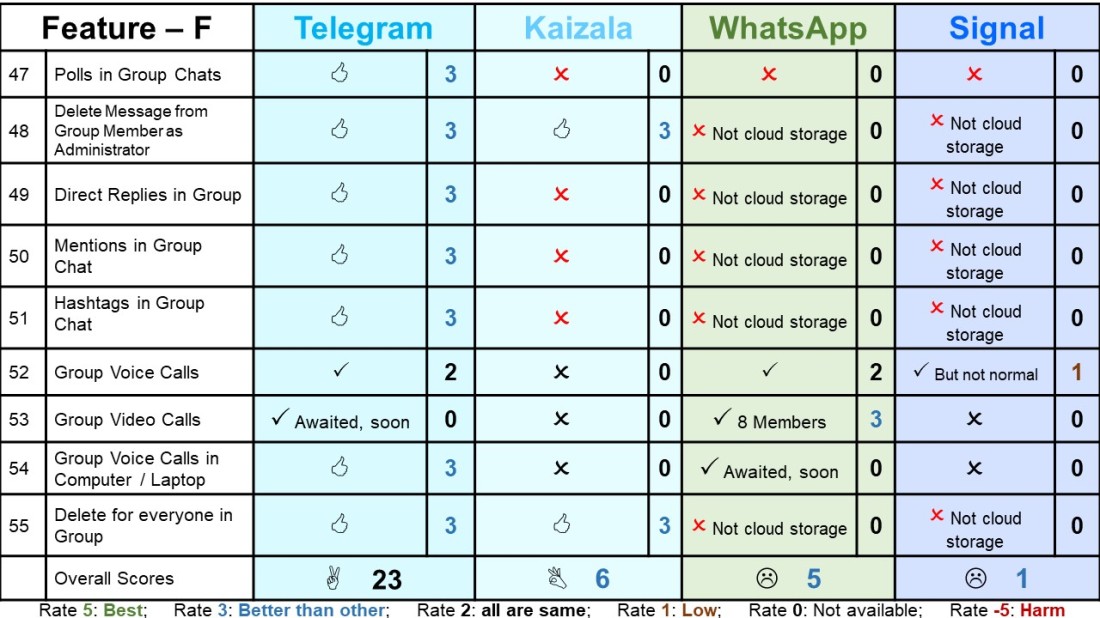
NOTE: Microsoft Kaizala has retired on 31st August 2023. Kaizala moved to Microsoft Teams from 1st September 2023.
12) Durgaa Chalisa
Worshipping goddess Durgaa during 9 days of Durgaa Puja celebration is of great significance among every Hindu Indians. People worship goddess Durgaa who is also recalled as goddess of Supreme Powers. The festival of 9 days thus comes as a time of opportunity for all devotees of goddess Durgaa pray goddess with great devotion and pay tribute to her supreme powers. So on this auspicious occasion of Durgaa Puja, recite Durgaa Chalisa in English, which is here on the page below:
Invoke the divine blessing of Durgaa Ma by reading aloud Shri Durgaa Chalisa everyday.
Durgaa Chalisa
Namo Namo Durge Sukh karani,
Namo Namo ambe Dukh harani.
Nirakar hai jyoti tumhari,
Tihun lok pheli ujayari.
Shashi lalat mukh mahavishala,
Netra lal bhrikutee vikarala.
Roop Matu ko adhika suhave,
Daras karat jan ati sukh pave.
Tum sansar shakti laya kina
Palan hetu anna dhan dina.
Annapurna hui jag pala,
Tumhi adi sundari Bala.
Pralaya kala sab nashan hari,
Tum gauri Shiv-Shankar pyari.
Shiv yogi tumhre guna gaven,
Brahma Vishnu tumhen nit dhyaven.
Roop Saraswati ko tum dhara,
De subuddhi rishi munina ubara.
Dharyo roop Narsimha ko amba,
Pragat bhayin phar kar khamba.
Raksha kari Prahlaad bachayo,
Hiranakush ko swarga pathayo.
Lakshmi roop dharo jag mahin,
Shree Narayan anga samihahin.
Ksheer sindhu men karat vilasa,
Daya Sindhu, deeje man asa.
Hingalaja men tumhin Bhavani,
Mahima amit na jet bakhani.
Matangi Dhoomavati Mata,
Bhuvneshwari bagala sukhdata.
Shree Bhairav lara jog tarani,
Chhinna Bhala bhav dukh nivarani.
Kehari Vahan soh Bhavani,
Langur Veer Chalat agavani.
Kar men khappar khadag viraje,
Jako dekh kal dan bhaje.
Sohe astra aur trishoola,
Jase uthata shatru hiya shoola.
Nagarkot men tumhi virajat,
Tihun lok men danka bajat.
Shumbhu Nishumbhu Danuja tum mare,
Rakta-beeja shankhan samhare.
Mahishasur nripa ati abhimani,
Jehi agha bhar mahi akulani.
Roop karal Kalika dhara,
Sen Sahita tum tin samhara.
Pan garha Santan par jab jab,
Bhayi sahaya Matu tum tab tab.
Amarpuni aru basava loka,
Tava Mahirna sab rahen asoka.
Jwala men hai jyoti tumhari,
Tumhen sada poojen nar nari.
Prem bhakti se Jo yash gave,
Dukh-daridra nikat nahin ave.
Dhyave tumhen jo nar man laee,
Janam-maran tako chuti jaee.
Jogi sur-muni kahat pukari,
Jog na ho bin shakti tumhari.
Shankar Aacharaj tap keenhon,
Kam, krodha jeet sab leenhon.
Nisidin dhyan dharo Shankar ko,
Kahu kal nahini sumiro tum ko.
Shakti roop ko maran na payo,
Shakti gayi tab man pachitayo.
Sharnagat hui keerti bakhani,
Jai jai jai Jagdamb Bhavani.
Bhayi prasanna Aadi Jagdamba,
Dayi shakti nahin keen vilamba.
Mokon Matu kashta ati ghero,
Tum bin kaun hare dukh mero.
Aasha trishna nipat sataven,
Moh madadik sab binsaven.
Shatru nash keeje Maharani,
Sumiron ekachita tumhen Bhavani.
Karo kripa Hey Matu dayala,
Riddhi-Siddhi de karahu nihala.
Jab lagi jiyoon daya phal paoon,
Tumhro yash men sada sunaoon.
Durgaa Chalisa jo gave,
Sab sukh bhog parampad pave.
Translation of Durgaa Chalisa in English
I bow to You O Goddess Durgaa, the bestower of happiness!
I bow to You O Goddess Amba, who Ends all miseries.
The radiance of your light is limitless and all pervading and all the three
realms (Earth, Heaven And the Nether World) are enlightened by Thee.
Your face is like the moon and mouth very huge. Your eyes shine with a
red glow and You have a Frightening frown.
O Mother! Your look is enchanting, the very sight of which ensures welfare
of the devout.
All the powers of the World repose in Thee and it is You who provide food and
wealth for the World’s survival.
Like the feeding Mother Annapurna, You nurture the whole universe and You are
the one Who appear like the timeless Bala Sundari (young girl of extreme beauty).
At the time of dissolution, it is You, O Mother, who destroys everything. You are the
beloved Consort of Lord Shiva, Gauri (Parvathi).
Lord Shiva and all yogis always chant your praise Brahma,
Vishnu and all other Gods ever meditate on You.
You appear in the form of Goddess Saraswathi too,
to grant wisdom to the sages and thus ensure their Welfare.
O Mother Amba! It was You who appeared in the form
of Narsimha, sundering the pillar.
Thus You saved Prahlad and Hiranyakashyap also went to
Heaven as he was killed by your Hands.
In the form of Goddess Lakshmi, O Mother, you appear in
this world and repose by the side of Shree Narayan.
Dwelling in the ocean of milk, O Goddess, with Lord Vishnu,
please fulfill my desires.
O Bhavani, the famous Goddess of Hingalaja is no one else but
You Yourself. Illimitable is your Glory, defying description.
You are yourself Matangi and Dhoomavati Mata. It is You who appear as
Bhuvaneshwari and Bagalamukhi Devi to bestow happiness to all.
It is You who redeem the world, appearing in the form of Shree Bhairavi,
Taradevi and Chhinnamasta Devi, and end its sorrows.
Reposing gracefully uopn your vehicle, O Goddess Bhavani, You are welcome
by the brave Langour (Lord Hanuman).
When You appear in the form of Goddess Kali, with sword in one hand and a
cupel in the other, Even Time flees in panic.
Beholding You, well armed, with a Trident in your hand, the enemy’s
heart aches with the sting Of fear.
You also repose in the form of Devi at Nagarkot in Kangara. Thus all the
three realms shudder in the might of your glory.
You slayed the demons like Shumbh & Nishumb and massacred the
thousand forms of the dreaded Demon Raktabeej.
When the earth was severely distressed bearing the load of the sins
of the arrogant Mahishasur.
You assumed the dreadful form of Goddess Kali and
massacred him along with his army.
Thus, whenever the noble saints were distressed,
it is You O Mother, who came to their rescue.
All the realms including the Amarpuri (divine realm) remain
sorrow-less and happy by Your Grace. O Goddess!
It is the symbol of Your glory that is burning brightly at Shree JwalaJi.
All me and women Ever worship You, O Mother!
He who sings Your glory with devotion, love, and sincerity remains
beyond the reach of grief And poverty.
He who meditates upon Your form with concentration goes
beyond the cycle of births and deaths.
All the yogis, gods and sages openly declare that without your
favour one can’t establish communion with God.
Shankaracharya had performed once a special penance called
Aacharaj and by virtue of which he had subdued his anger and desire.
He ever worshipped Lord Shankar and never for a moment
concentrated his mind on You.
Since He did not realise your immense glory, all His powers
waned and then He repented hitherto
Then He sought refuge in You, chanted Your glory and
‘victory, victory, victory to Thee, O Jagadamba Bhavani’.
Then, O Primal Goddess Jagadamba Ji, You were propitiated and
in no time You bestowed Him with his lost powers.
O Mother! Severe afflictions distress me and no one except Your
Honoured Self can provide relief please end my afflictions.
Hopes and longings ever torture me. All sorts of passions and
lust ever torment my heart.
O Goddess Bhavani! I meditate only upon you Please
kill my enemies O Queen!
Merciful Mother! Show me your favour and make me feel
happy by bestowing me with all sorts of riches and powers.
O Mother! May I be receptable of Your grace as long as I live,
ever recounting the feats of Your Glory to all.
This way, whoever sings this Chalisa shall ever enjoy all
sorts of pleasures and shall attain the highest state in the end.
Telegram Channel: Join at World Hindu & Health Instruction (@WorldHinduHealth)
[ https://t.me/WorldHinduHealth ]
World Hindu & Health Instruction : Index – Videos List
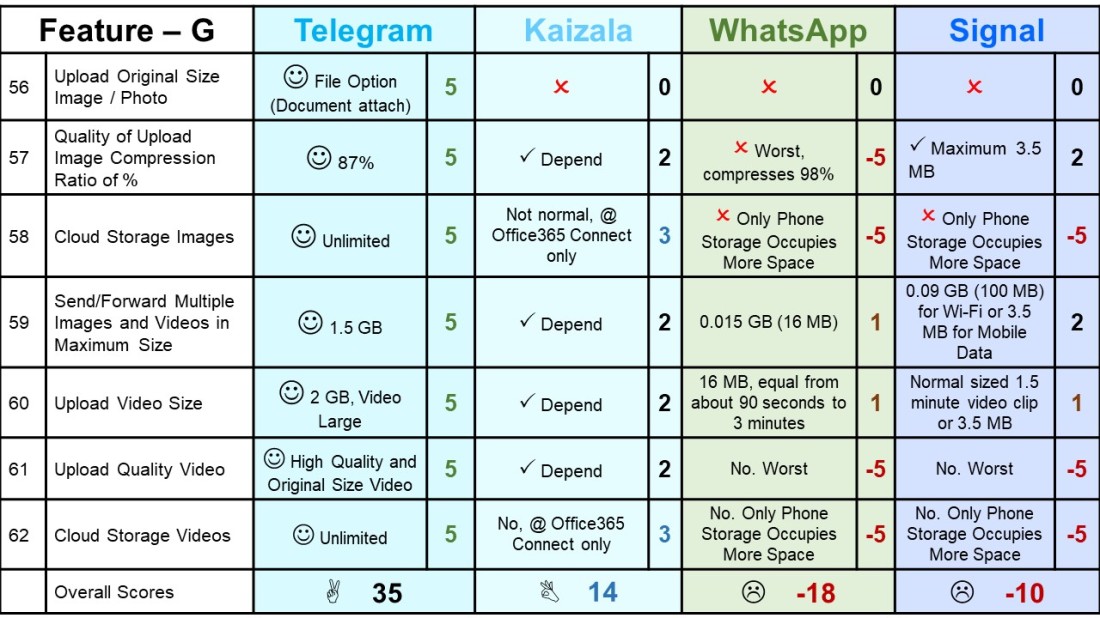
NOTE: Microsoft Kaizala has retired on 31st August 2023. Kaizala moved to Microsoft Teams from 1st September 2023.
13) Nine Days of NAVARAATHRI
Navaraathri festival is a nine days celebration, and these nine days are separated into three set of three days. As, each day of these nine days is devoted to nine form of supreme Goddess, three set of three days adore different facet of mother power. First three days are devoted to Supreme source of power, Goddess Durgaa. The Goddess is destined to all ours ills, evils and defects. Another segment of three days is devoted to Goddess of spiritual wealth, Lakshmi. Goddess Lakshmi is considered to have power to bless her devotees with never-ending wealth. In final segment of three days, Goddess of wisdom, Saraswathi is worshipped. Goddess Saraswathi brings overall success in life and a medium for spiritual enlightenment.
Mother Durgaa is adored under nine different names on each day of Navaraathri. Every day she gets a new personality, nature, appearance, and obligation. These nine forms of Mother Durgaa are Shailputhri, Brahmacharini, Chandraghanta, Kushmanda, Skanda Mata, Katyayani, Kalrathri, Maha Gauri and Siddhidathri. On Initial six days, festival and devotion is restricted to home. The Navaraathri celebration gets its festive form since seventh day when the festivity of Navaraathri spread around.
Video # 13
First Day Puja
The first day of Navaraathri Puja is devoted to Shailputhri. Goddess Shailputhri is daughter of Himalayas. She is a form of Mata Shakthi (Goddess of Power) and spouse of Lord Shiva.
1 Day – Goddess Durgaa Shailputhri
Second Day Puja
On the second day of Navaraathri Goddess Brahmacharini is worshipped in homes and temples. The word ‘Brahmcharini’ is derivative of the word Brahma, which stands for Tapa (Penance). This form of mata Sakthi is close to Uma or Paarvathi.
2 Day – Goddess Brahmacharini
Third Day Puja
Goddess Chandraghanta is worshipped on the third day of Navaraathri. She is considered to be Goddess of beauty and bravery.
3 Day – Goddess Chandraghanta
Fourth Day Puja
The form of Mata Sakthi which is worshipped fourth day of Navaraathri is Kushmanda. As per Hindu mythology, it is considered that the Goddess Kushmanda has originated this entire Universe by her laugh.
4 Day – Goddess Kushmanda
Fifth Day Puja
Devotees worship Skand Mata on the fifth day of Navaraathri. Skanda is chief warrior of God’s army and Goddess is mother of Skanda that is why the Goddess is called Skand Mata.
5 Day – Goddess Skandamata
Sixth Day Puja
Sixth day of Navaraathri is intended for Devi Katyayani. In her typical image, the goddess Katyayani seated on lion and has tree eyes and four legs.
6 Day – Goddess Kathyayani
Seventh Day Puja
On the seventh day of Navaraathri festival, devotees worship and adore the Goddess Kaalaraathri. As name indicates Devi Kaalaraathri is as black as a dark night and she is notorious to eliminate fear from her devotee’s heart.
7 Day – Goddess Kaalaraathri
Eighth Day Puja
Maha Gauri is the form of Mother Durgaa which is worshipped on eighth day of Navaraathri. The Goddess Maha Gauri signifies calmness and endorses wisdom. As name suggest, she is considered enormously beautiful. Her color is like snow and adorned with white colored jewelries.
8 Day – Goddess Mahagauri
Ninth Day Puja
Ninth form of the Goddess Durgaa, Siddhidathri is worshiped on the ninth day of Navaraathri. She is Goddess of all eight siddhis and is worshipped by all Yogis, Sadhakas, Siddhas and Rishis-Munis.
9 Day – Goddess Siddhidathri
Telegram Channel: Join at World Hindu & Health Instruction (@WorldHinduHealth)
[ https://t.me/WorldHinduHealth ]
World Hindu & Health Instruction : Index – Videos List
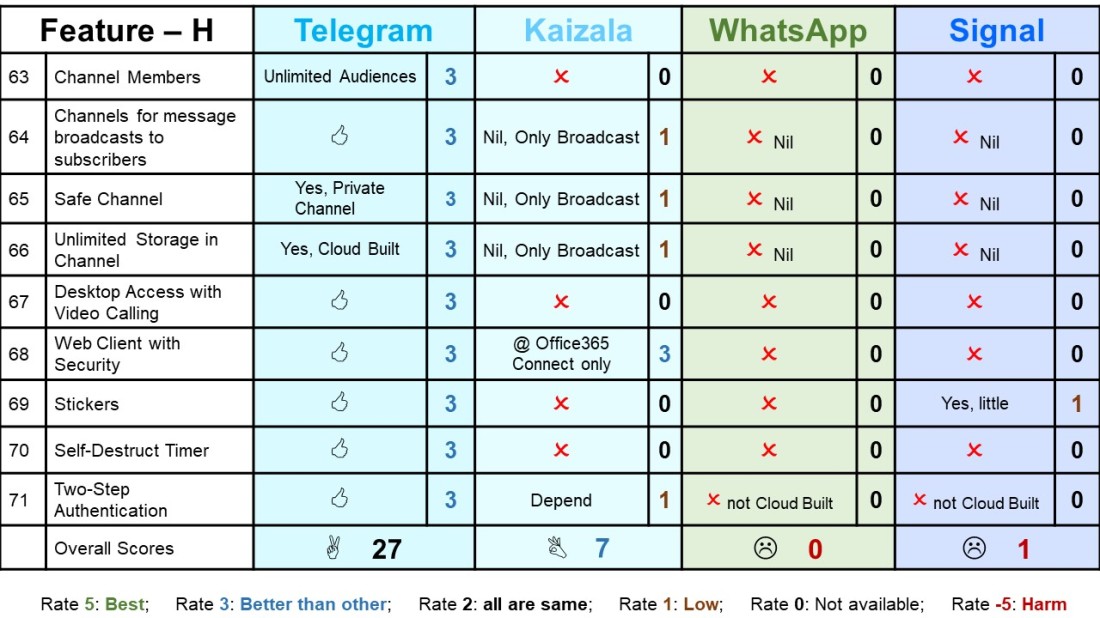
NOTE: Microsoft Kaizala has retired on 31st August 2023. Kaizala moved to Microsoft Teams from 1st September 2023.
14) Navaraathri Songs
Navaraathri, the 9 days long festival celebration of India is a holy festival celebration that is celebrated with great devotion, zeal and grandeur by the devotees of goddess Durgaa. It is one of the most cheerfully celebrated Indian festivals. And now when just few days are left for the approaching Navaraathri festival celebration, people are getting busy for the festival preparations. Thus, here below some popular Navaraathri Songs for you to sing at cultural programs of the festival help at various Navaraathri celebration centers.
Below are 4 devotional Navaraathri Songs with Lyrics:
A. AAO MERI SHERAWALI MAA
Aao meri shera waali maa
O maa o maa o maa…
Aao meri jyota waali maa
O maa o maa…
Mere soye bhag jaga do
O maiya meri jagdambe
Meri bigdi aaj bana do
O maiya meri jagdambe
Aao meri shera waali maa
O maa o maa
Aao meri jyota waali maa
O maa o maa
Jai maa jai maa
Jai jai maa
O sunke mahima teri niraali
Aaya dar per ek sawali
Vo dukhiyara janam se andha haal bada tha uska manda
Tadap ke bola aakho ke bin patthar hai here moti
Naina devi mata hai to de mere naino ko jyoti
De mere naino ko jyoti
Teri daya se mit gaya uski aakho se andhiyara
Aao meri jyota devi maa
O maa o maa
Aao meri naina devi maa
O maa o maa
Ek din ek abhagan maari kahne lagi dukhda apna
Apna dukhda
Maa apne bhakton ko dekho kitna dard pade sahna
Kitna dard pade sahna
Tune to kitani maaon ko
Bakshi aakho ke tare
Daya karon mujhpe itni ki koi maa kahke pukare
Dayabhai jab teri maiya usaki god bhari khali
Aao meri jag janani maa – 2
B. AMBE TU HAI JAGDAMBE KALI
Ambe tu hai jagdambe kali jay durge khappar wali
Tere hi gun gaye bharthi ho maiya ham sab utare teri aarthi
Tere jagat ke bhakt janan par bheed padi hai bhari maa
Danaw dal par toot pado maa karke singh sawari
Sau sau singho se tu bal shali
Asth bhujao wali dushton ko pal mein sangharti
O maiya hum sab utarey teri aarthi
Maa bete ka hai ish jag mein bada hi nirmal nata
Poot kaput sune hai par na mata suni kumata
Sab par karuna darshane wali amrit barsane wali
Dukhiyon ke dukhade nivarthi
O maiya hum sab utare teri aarthi
Nahi mangte dhan aur daulat na chandi na sona maa
Hum to mange maa tere man mein ek chhota sa kona
Sab ki bigdi banane wali laaj bachane wali
Satiyo ke sat ko sanwarti
O maiya hum sab utare teri aarthi
Ambe tu hai jagdambe kali jay durge khappar wali
Tere hi gun gaye bharti ho maiya ham sab utare teri aarthi
C. AAJA MAA GHAR MERE
Maan le mera kahana maiya wari jau tere
Aaja maa ghar mere aaja maa ghar mere
Maan le mera kahana maiya – 2
Wari jau tere aaja maa ghar mere
Aaja maa ghar mere
Tera pujari mera sara parivar maa
Tere shub charno se humko bada pyar maa
Tere dularo ko hai tera intzaar maa
Aaja ek baar maa hoga bada upkar maa
Jot mere ghar me jalti hai teri shaam sabere
Aaja maa ghar mere aaja maa ghar mere
Maan le mera kahana maiya wari jau tere
Aaja maa ghar mere aaja maa ghar mere
Hatho mein teri mehandi pyar se rachayenge
Foolo se tera darbaar maa sajayenge
Chandan ki chauki pe tujhe ham bithayenge
Saari saari rat maiya bhete sunayenge
Sanso ki ektara maiya tere naam ki mala fere
Aaja maa ghar mere aaja maa ghar mere
Maan le mera kahana maiya wari jau tere
Aaja maa ghar mere aaja maa ghar mere
Tu hai vishvaas maiya tu hi meri astha
Der naa lagana tujhe mamata ka wasta
Teri gufa se meri kutiya ka rasta
Lamba nahi hai daati tujhako bhi hai pata
Ek jhalak dekhu teri to man ke mite andhere
Aaja maa ghar mere aaja maa ghar mere
Maan le mera kahana maiya wari jau tere
Aaja maa ghar mere aaja maa ghar mere
D. AAJA MAA TENU AKHIYAN UDIK DIYA
Aaja maa tenu akhiyan udik diya
Udik diya dil vaja marda
Aaja maa tenu akhiyan udik diya
Tere bina kaun tere lal ko sambhale maa – 2
Aake ek baar mujhe gale se laga le maa – 2
Dukh intjar da dukh nahi sahar da
Akhiyan udik diya
Dil vaja marda
Aaja maa tenu akhiyan udik diya
Daras dikha ke mere saare dukh taal de – 2
Bhichchha daya ki meri jholi mein daal de – 2
Pyasa hun pyar da tere didar da
Akhiyan udik diya
Dil vaja marda
Aaja maa tenu akhiyan udik diya
Telegram Channel: Join at World Hindu & Health Instruction (@WorldHinduHealth)
[ https://t.me/WorldHinduHealth ]
World Hindu & Health Instruction : Index – Videos List
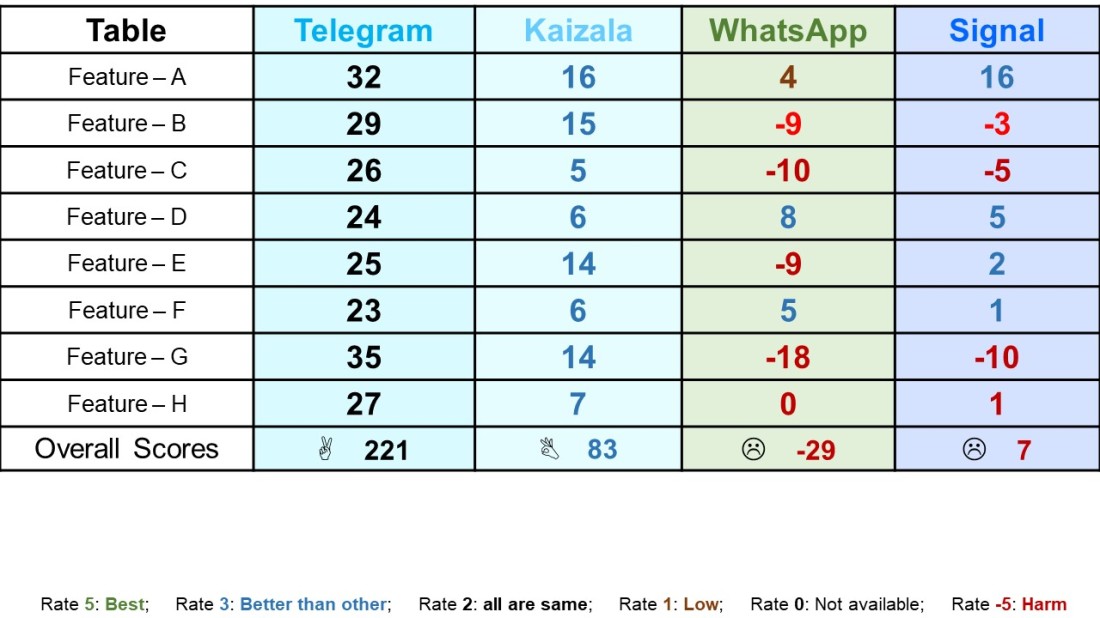
NOTE: Microsoft Kaizala has retired on 31st August 2023. Kaizala moved to Microsoft Teams from 1st September 2023.
Join Us
| Telegram Channel | Twitter | LinkedIn Page | Microsoft Teams | Other Social | WhatsApp Channel | Blogger |
15) Mata Temples in India
There are innumerable temples throughout India, dedicated to Ma Durgaa, the true manifestation of the absolute energy that pervades the universe. These temples helps to promote and flourish the richness of the Hindu religion, culture, and philosophy. In addition, the various Durgaa temples provides an opportunity for the Hindu community to learn and display the many characteristics possessed by Ma Durgaa through participation in rituals, customs and various other activities, performed in the temples.
- Vaishno Devi Temple, Jammu and Kashmir
- Kamakhya Temple, Guwahati, Assam
- Mansa Devi Temple, Churu, Rajasthan
- Karni Mata Temple, Deshnoke, Rajasthan.
- Chamunda Devi Temple, Himachal Pradesh
- Kalkaji Mandir, Delhi
- Durgiana Temple, Amritsar, Punjab
- Amba Mata Temple, Junagadh, Gujarat
- Chartarpur Temples, Delhi
- Jwalamukhi Temple, Himachal Pradesh
- Naina Devi Temple, Nainital, Uttarakhand
- Mookambika Devi Temple, of Kollur, Karnataka
- Vidyashankara Temple at Sringere, Karnataka
- Chamundeswari Temple of Chamundi Hill, Mysuru, Karnataka
- Dakshineswar Kali Temple, Kolkata, West Bengal
- Mangalagauri Temple, Gaya, Bihar
- The Durgaa Temple, Varanasi, Uttar Pradesh
- Devi Kanaka Durgaa, Vijayawada, Andhra Pradesh
- Shree Durgaa Parameshwari Temple, Kateel, Karnataka.
- Chandi Devi, Haridwar, Uttarakhand
- Bhagavathi Temple, Kanyakumari, Tamil Nadu
- Devi Patan Temple,
- Bhadrakali Temple at Hanamkonda, Warangal, Thelangaana
- Annapurneshwari Temple of Horanadu, Karnataka
- Marikamba Temple, of Sirsi Karnataka
- Banashankari Temple, near Badami, Karnataka
- Bhadrakali Temple
- The Durgaa Temple Aihole
Telegram Channel: Join at World Hindu & Health Instruction (@WorldHinduHealth)[ https://t.me/WorldHinduHealth ]
World Hindu & Health Instruction : Index – Videos List
Contd…
https://twitter.com/worldinformativ
16) The Rituals of Durgaa Puja
The festival of Durgaa Puja starts with Mahalaya, the first phase of the waxing moon in Aswin. Thousands offer prayers to their ancestors at the city’s river banks, a ritual called Tarpan. The inauguration of the Goddess idol starts on Mahashasthi. The main puja is for three days – Mahasapthami, Mahaasthami, Mahanavami. The puja rituals are long and very detailed and complicated. Three days of Mantras and Shlokas and Arathi and offerings – needs an expert priest to do this kind of Puja. Because of these facts, the number of Pujas held in the family has reduced and Durgaa Puja has mostly emerged as a community festival.
Mahashashthi
On this day Goddess Durgaa arrives to the mortal world from her heavenly abode, accompanied by her children. She is welcomed with much fanfare amidst the beats of dhak. Unveiling the face of the idol is the main ritual on this day. Kalaparambho, the ritual performed before the commencement of the puja precedes Bodhon, Amontron and Adibas.
Mahasapthami
Saptami is the first day of Durgaa puja. Kola Bow or Nabapatrika is given a pre-dawn bath. This is an ancient ritual of worshiping nine types of plants. They are together worshiped as a symbol of the goddess. The main Sapthami Puja follows Kalparambho and Mahasnan.
Mahaasthami
The day began with a recital of Sanskrit hymns in community puja pandals as thousands of devotees offered anjali to the goddess. Kumari Puja or the worship of little girls as the mother goddess was a special part of the rituals observed in a number of traditional and household pujas. As the day wore on, it was time for the important Sandhi Puja, which marks the inter-linking of the Maha Ashthami and Maha Navami.
Mahanavami
This is the concluding day of Durgaa Puja. The main Navami puja begins after the end of Sandhi Puja. The Navami Bhog is offered to the goddess. This is later partaken as prasadam by the devotees.
Dashami
After the three days of Puja, in Dashami , in the last day, a tearful farewell is offered to the Goddess. Most of the community pujas postpone the farewell as long as possible and arrange a grand send-off. The images are carried in processions around the locality and finally is immersed in a nearby river or lake. Vijaya Dashami is an event celebrated all over the country.
Contd…
https://www.linkedin.com/company/informativeandentertaining/
17) Durgaa Puja Recipes
Vegetarian Alu Dum
Ingredients:
Potatoes (small) – 500 gms
Mustard – 1/2 table spoon
Curry leaves – 8-10 (Small)
Bay leaves – 2
Tamarind – 50 gms
Chilli Powder – 1/2 table spoon
Chillies (green) – 5
Salt according to taste
Ginger paste – 1 table spoon
Garlic paste – 1/2 table spoon
Sugar – 1 table spoon
Refined oil – 3/4 table spoon
a. Boil potatoes and peel off the skins.
b. Soak tamarind in a cup of water for 10 minutes and strain the juice.
c. Heat oil in pan and fry ginger, garlic, mustard, bay leaves with some sugar till brown.
d. Then add the boiled potatoes & fry until the potatoes becomes golden brown.
e. Then add chillies, curry leaves, salt & add tamarind juice.
f. Stir & serve hot with luchi / puri.
Fulkopir Vada
Ingredients:
Cauliflower – 1.
Besan – 1 cup.
Oil-1 teaspoon.
Water.
Posto (poppy seeds)- 1/2 teaspoon.
Chili powder-1/2 teaspoon
Salt to taste.
Oil for deep-frying.
Baking soda (optional)- a pinch.
Method:
1. Cut the cauliflower into medium sized pieces. Boil them so that they become soft on the exterior but remain hard inside.
2. Pour besan in a large bowl and add 1 teaspoon oil. Mix thoroughly.
3. Add water and make batter with a relatively thick consistency.
4. Add the posto, chili powder and salt and whip batter well.
5. Dip the cauliflower pieces in the batter and deep-fry them.
Luchi /Puri
Ingredients:
Wheat Flour – 500 gms
Refined oil or Ghee – 2 table spoon
Salt according to taste
Warm water to knead the flour
Oil to fry
Method:
a. Knead 500 gms of flour, 2 tablespoon of oil & salt according to taste with warm water.
b. Make small doughs.
c. Flatten them into round circular form.
d. Fry them one by one. Serve hot with other side dish.
Bhaat
Ingredients:
Long grain or basmathi rice – 2 cups
Water – 3 cups
Salt to taste
Method:
1. Wash rice in several changes of water.
2. Place the rice and water in a deep saucepan, put over medium heat and bring to a boil.
Cook until rice becomes soft.
3. Drain the water. Serve hot.
Mung Dal
Ingredients:
Mung Dal – 200 gms
Small whole pearl onions-10
Green chilies – 4
Milk – 1/2 cup
Sugar – 1 teaspoons
Salt to taste.
Ghee – 1 table spoon
Bay leaves – 4
Whole cumin seeds – 1/2 teaspoon
Method:
a. Fry the dry mung dal in a pan over medium heat until it becomes brown.
b. Wash and put mung dal to boil.
c. Simmer until dal is cooked.
d. In a separate pan, heat ghee and fry the bay leaves, onions and cumin seeds for a few minutes.
e. Pour the dal and simmer for 5 minutes.
f. Add 1/2 cup of milk and sugar.
Ingredients:
Besan 250 gms
A pinch of bicarbonate of soda
Powdered rice- 50 gms
Water-1 and half cup
Oil for deep frying-1 and half cup
Sugar- 4 cups
Water- 4 cups for making syrup
Method:
1. In a pan heat together 4 cups of sugar and water.
2. Let it boil and simmer until the syrup is of medium consistency.
3. Remove from fire and allow it to cool.
4. Blend together besan and 1 and half cup of water.
5. Mix the powdered rice and bicarbonate of soda.
6. Heat oil in a deep pan and pour the besan mixture on the hot oil through a slotted vessel.
7. Fry until crisp.
8. Remove from oil with a slotted spoon. Drain out the oil in a paper. 9. While still hot pour in the prepared syrup. Continue this until the besan mixture is over.
10. After the Bonde is soaked in the syrup remove with a slotted spoon and spread out on a flat dish.
Microsoft Teams:
Microsoft Channel: https://teams.live.com/l/community/FEADDwY3GumMAPqSwI
18) Navaraathri Recipes
During the Navaraathri fest, people from major parts of North, south and central India observe fast of all nine days. A number of people choose to fast only first and ninth day of the Navaraathri. Ritual fast is a way of devotion and to pay gratitude to Goddess Durgaa. As per Hindu tradition, consuming alcohol and non-vegetarian food is highly restricted and considered inauspicious and gloomy. There are certain scientific reasons behind this restriction. During the days of Navaraathri or any other auspicious or holy occasion, people are supposed to avoid consuming alcohol, meat, grains, salt, onion, garlic etc. As per Ayurvedic perception, these foods are ‘Tamsik’ and they attract as well as absorb negative vibes. Therefore, such foods need to be avoided during such auspicious occasion.
SABUDANA KHICHDI RECIPE

Sabudana Khichdi is one of the most delicious and much preferred fast recipes among all. It is easy to make and a healthy dish for the ones on Navaraathri fast for 9 days. Tapioca Sabudana pearls cooked with potatoes and peanuts make it an excellent dish to relish during the suspicious time of Navaraathri. There are several ways of cooking Sabudana Khichdi. However this recipe of Sabudana Khichdi is much preferred buy all.
Recipe type: Snacks
Cuisine: Indian
Prep time- 8 hours
Cook time- 30 minutes
Total time- 8 hours and 30 minutes
Serves: 3-4
Ingredients (measuring cup used, 1 cup = 250 ml)
- 1 cup sabudana or tapioca pearls
- ½ cup roasted peanuts/moongphali
- 2 small to medium size potatoes/aloo
- 2 tbsp oil
- ¼ cup grated fresh coconut (optional)
- tsp grated ginger/adrak (optional)
- 1 tsp cumin/jeera
- 1 green chili/hari mirch, chopped
- ½ to 1 tsp lemon juice or as required (optional)
- 8-10 curry leaves/kadi patta (optional)
- ½ to 1 tsp sugar or as required
- Rock salt as required
Step-by-step Recipe for Sabudana Kitchdi:
- In a big bowl, soak sabudana overnight or just for 3-5 hours.
- Next day drain sabudana nicely and keep it aside in a bowl.
- Then boil potatoes.
- After potatoes are boiled peel and chop them when warm.
- Now in a pan dry roast the peanuts till browned
- When it is cooled do make a coarse powder in a mortar-pestle or in any dry grinder.
- Then mix coarsely powdered peanuts, sugar and salt with drained sabudana.
- In a pan heat oil to fry the cumin first till they crackle and turn brown.
- It’s time now to add the curry leaves & green chilies in it.
- Fry it for half a minute and then mix grated ginger in it.
- Keep on stirring it till the raw smell of the ginger is no more.
- Add potato in it and sauté it for 1-2 minutes.
- Now add sabudana and keep on stirring this mixture.
- When the sabudana starts losing its opaqueness and turns into translucent they are cooked.
- Remember not to overcook it as it might turn lumpy and hard.
- Then lastly add grated coconut in and mix it well. Close the flame.
- While serving you can garnish sabudana khichdi with coriander leaves and drizzle some lemon juice over it.
- Your sabudana khichdi is ready to be served hot.
KUTTU KI KHICHDI

If you are willing to make delicious Kuttu ki Khichdi which your mother or Bhabhi use to cook during Navaraathri fast then here is the solution to it. Below is the recipe of yummy Kuttu Ki Khichdi for you to cook with great ease. The recipe of Kuttu ki Khichdi shared below is easy and much preferred by all to relish during Navaraathri fasting days.
Prep Time: 11-15 minutes
Cook time: 16-20 minutes
Serve: 4
Level of Cooking: Easy
Taste: Mild
Ingredients for Kuttu Khichdi Recipe:
- Ghee 1 tablespoon
- Buckwheat (kuttu) 1 cup
- Potatoes peeled and cut into small cubes 2 medium
- Cumin seeds 1/2 teaspoon
- Ginger finely chopped 1/2 inch
- Green chilli finely chopped 1
- Peanuts roasted and crushed 2 tablespoons
- Salt to taste
- Sugar 1 teaspoon
- Lemon juice 1 teaspoon
- Fresh coriander leaves chopped 1 tablespoon
- Lemon wedges to serve
Method of Cooking
Step 1: First heat ghee in a non-stick pan and then add cumin seeds. Sauté till seeds starts changing color.
Step 2: Now add green chilli and ginger in it, mix and sauté everything for few seconds.
Step 3: Add potatoes and sauté for 2-3 minutes or till potatoes starts turning crisp from the edges.
Step 4: It’s time now to add peanuts into it and then sauté it for half a minute.
Step 5: Now add buckwheat into it to mix it well and sauté it for one to two minutes.
Step 6: After all this now you need to add 2 cups water, salt and sugar. Then mix it well, cover it to let it cook on low heat till it is fully done.
Step 7: Then add coriander leaves lemon juice. Mix well.
Step 8: Now it’s ready to be served hot with a lemon wedge.
ALU PANEER KOFTA RECIPE

This is another classic Recipe of Punjabi’s from North Indian cuisine. This recipe of Alu Paneer Kofta recipe has 2 separate parts. In first part it’s the making of kofta with alu and paneer and then in the second part it is the making of tomato-based gravy. Once you are done with complete Alu Paneer Kofta recipe as been described, you are sure to impress your loved ones. This is one of the hit Navaraathri recipe which you must try.
Preparation Time: 15 minutes
Cooking Time: 35 minutes
Servings:2
Ingredients for Alu-Paneer Kofta:
- 2 medium Potatoes, boiled, peeled and grated
- 200 gm Paneer (cottage cheese), grated
- 6-8 Cashew nuts, chopped
- 1/2 teaspoon grated Ginger
- 1 finely chopped green chilli
- 1/2 teaspoon Lemon Juice
- 1½ tablespoons Corn Flour
- 2 tablespoons finely chopped coriander leaves
- Oil for deep frying
- Salt to taste
Ingredients for Gravy:
- 2 tablespoons Cashew nuts, soaked in water for 20 minutes
- 3 medium Tomatoes
- 1 Green Chilli, seeded and finely chopped
- 2 teaspoons crushed Garlic-Ginger
- 1 medium Onion, finely chopped or grated
- 1/2 teaspoon Kasuri Methi (dried fenugreek leaves)
- 1/2 teaspoon Cumin Seeds
- 1/4 teaspoon Garam Masala Powder
- 1/2 teaspoon Red Chilli Powder
- 1/2 inch piece of Cinnamon Stick
- 1/4 teaspoon Turmeric Powder
- 1½ teaspoons Coriander Powder
- 1/2 teaspoon Sugar
- 3/4 cup Water
- 2 Cloves
- Salt to taste
- 2 tablespoons Oil
Directions for Making Kofta of Paneer:
- 1. At first take grated potatoes, grated paneer, corn flour, ginger, green chilli, coriander leaves, lemon juice and salt in a big bowl.
- To make a smooth mixture of all mix these well.
- Now grease your palms with oil and then divide this mixture into 6-8 equal portions.
- Pick each and give each portion the shape of a ball.
- After this, take one ball and press a little between your palms to flatten it like pattie.
- You can put 2-3 pieces of cashew nuts in the center (this is a stuffing).
- Wrap each of these in from all the sides and give it round shape of ball. In the same way, prepare remaining stuffed kofta balls.
- Now in a frying pan, heat oil over medium flame.
- When it turns medium hot, slide in 3-4 stuffed balls carefully from the edge of frying pan and deep-fry these balls over medium flame until they start turning golden brown and crisp. It is important to assure that oil is very hot otherwise it may break or split.
- Now drain these and transfer them to a plate. Repeat the process for remaining stuffed balls.
Directions for Making Tomato based Gravy:
- To make tomato puree, blanch the tomatoes and then add grind soaked cashew nuts with 2 tablespoons of water in it to make a paste.
- In a pan heat oil over medium flame.
- Now add cumin seeds in it. When these begin to crackle, add cinnamon and cloves. For 30 seconds approx sauté it well.
- It’s time now to add crushed garlic-ginger and sauté it for 10-20 seconds.
- After this add chopped green chilli and onion. Sauté it well until onion turns light brown. This will take approx. 2-3 minutes.
- Add tomato puree (prepared in step-1).
- Sauté until oil starts to separate, 3-4 minutes.
- Add cashew nut paste (prepared in step-1), turmeric powder, red chilli powder, coriander powder, garam masala powder, sugar and salt.
- Keep stirring it and let it cook for a minute.
- Now add kasuri methi and 1/2 cup of water in it. Let the gravy cook for 4-5 minutes.
- This is the time to add prepared stuffed balls and to it mix well. After few seconds turn off the flame.
- Transfer your Alu paneer kofta curry to a serving bowl and garnish it with grated paneer.
KADDU KI SABZI

If you love to eat Kaddu ki Sabzi with puri during 9 days of Navaraathri fast but don’t know the right way to cook it then you are the right page as here we have come up with a delicious recipe of Kaddu ki Sabzi. This recipe will guide you the best way to make the popular and delicious Kadu ki Sabzi in the right way. You can try this and let your family enjoy a tasty treat during the auspicious time of Navaraathri festival.
Recipe type: Main course
Cuisine: Indian
Preparation time:20 minutes
Cook time: 15 minutes
Total time: 35 minutes
Servings: 4
Ingredients (measuring cup used, 1 cup = 250 ml)
- 1 medium sized pumpkin/kaddu
- ½ tsp turmeric powder/haldi
- 1 tsp dry mango powder/amchur
- ¼ tsp garam masala powder
- 1 or 2 dry red chilies (optional)
- ¼ tsp fenugreek seeds/methi seeds
- 1 tsp sugar or 2 tsp crushed jaggery
- 1 tsp cumin seeds/jeera
- ½ tsp red chili powder/lal mirch powder
- ¾th cup or 1 cup water
- 2 tbsp oil
- Sendha namak/ Rock salt if on fast or common salt if not making during fasting
- Few chopped coriander leaves for garnishing (optional)
How to make the recipe:
- Firstly wash the pumpkin then peel and chop the pumpkin too.
- Now in a pressure cooker or any pan heat oil.
- It’s time now to add fenugreek seeds as well as cumin seeds and fry both for a minute on a low flame.
- Then add red chilies and again fry for around 15 seconds.
- Add chopped pumpkin and mix all the dry spice powders except dry mango powder and garam masala in it.
- Now add the sugar or jaggery in it.
- Do mix pumpkin with all rest of the spices and sugar/jaggery.
- Also add water and salt in it.
- It’s best time to cover the cooker with a lid and pressure cook it for 7-8 minutes.
- If you do not have a pressure cooker then try to cover the pan with a lid
- Let the pumpkin cook for some 15-20 minutes till it becomes soft and mushy.
- Now mash all your cooked and soft pumpkin with the help of a spoon and then add garam masala as well as dry mango powder.
- Well stir the mashed pumpkin and let it cook for 1-2 minutes.
- If the kaddu ki sabzi still seems watery to you, then evaporate water from sabzi by cooking it without covering it with lid.
- Your sabzi should not be watery nor be dry, it should be something in between state.
- Now garnish it with coriander leaves and serve kaddu ki sabzi hot.
DAHI ALU

During 9 days of fast in Navaraathri, people try many different vrat recipes; However Dahi Alu is one such recipe that is cooked by everyone during the auspicious Navaraathri festival. It is simple, tasty and flavorful dish that is loved by all. Every home follows a different method of cooking Dahi Alu. So here I have come up with completely different recipe of the Dahi Alu that can be cooked easily and will definitely make you feel good during Navaraathri fast. (You can replace normal salt with sendha namak and skip the use of red chilli powder if you do not consume it during Navaraathri fast). .
Cuisine: Indian
Category: Main course – Curry
Preparation time: 20 minutes
Cooking time: 15 minutes
Servings: 2
Ingredients:
- Potatoes – 2 medium or 1 ½ cups boiled, peeled and cubed
- Peanuts – 1 tablespoon, coarsely ground
- Plain yogurt or curd – ⅓ cup
- Cumin seeds – ½ teaspoon
- Ginger paste or freshly grated – 1 teaspoon
- Green chili – 1, chopped finely
- Cumin powder – 1 teaspoon
- Red chili powder – 1 teaspoon
- Cilantro or coriander leaves – few, chopped finely
- Water – ⅔ cups
- Ghee or clarified butter – 1 tablespoon
- Salt as per taste
Step by Step Recipe to Make Dahi Alu
- Firstly step to start with is to boil the potatoes for which take washed potatoes in a pressure cooker; add enough water so they are submerged in it. Then cover it with lid and put the weight on to cook it on medium flame.
- Let potatoes cook for 2-3 whistles (time or number of whistles may vary as per your potato size or type). Let pressure go down by itself then open the lid and let the potato cool down.
- During this time take yogurt in large bowl or cup, add some water in it.
- Now whisk it well till it is smooth and keep it aside.
- When potatoes are cool enough to touch with bare hands, cube them into medium size pieces.
- Grate the ginger and Chop green chilies as well.
- It’s time now to heat the ghee in a pan on medium flame. After the oil turns enough hot add cumin seeds to let them sizzle.
- Now add ginger and green chilies in it and sauté this for a minute.
- Add crushed peanuts in it.
- Mix it well and let it cook for a minute.
- It’s better to lower the heat on medium-flame and add cumin powder, red chili powder and salt in it.
- Stir it well and cook for around 30 seconds. If spices start burning then add few splash of water on it and then add boiled potatoes.
- Mix it well, so that all the masala gets coated with spices.
- Now its time to add earlier prepared yogurt-water mixture and then lower the heat bit early, so that yogurt won’t start to curdle with unfavorable temperature.
- The again stir everything well and cook it in a very low heat.
- Now let it cook for 7-8 minutes in very low flame. Do stir it in between..
- After this try mashing few pieces of potatoes using the back of spatula. This mashing of potatoes will help you to thicken your Dahi Alu gravy.
- Then again bring it on simmer flame for 1-2 minutes or till gravy starts becoming thick.
- Lastly add chopped cilantro leaves over it.
- Mix it well too and turn off the stove.
- Your delicious Dahi Alu is now ready to be served hot.
Serving suggestions: If you are making this Dahoi Alu for vrat then you can serve it with singhare ki puri, rajgire ka paratha, rajgira puri or kuttu ki puri or even with kuttu ka paratha. And if you are serving this delicious Dahi Alu sabzi on a regular day, you can have it with rothi, puri or crunchy paratha.
JEERA ALU

If you don’t want to spend much time in kitchen and still wish to eat something tasty, then you can prepare Jeera Alu in few minutes. The plainly crushed cumin seeds add ample texture, taste and coat the boiled potato pieces nicely. There is no set recipe to prepare it as everybody has a special way of preparing jeera alu and this combination is so perfect that it always turns out delicious. This dish is easy to cook and ideal to eat during fasts. You can serve it with different kind of chapathi and with rice.
Ingredients for Jeera Alu Recipe
- 4 Boiled large potatoes in 1 inch pieces
- 1 tablespoon cumin seed
- 4 table spoon Mustard/refined oil
- Salt as per taste
- 1 teaspoon Red chili power
- 1 tablespoon Coriander seeds powder
- 1 teaspoon powder of roasted cumin
- ½ teaspoon amchur (Dry mango powder)
- 2 tablespoons Fresh coriander leaves
Method
- Heat oil in a pan or kadahi
- Now add seeds of cumin in hot oil and let the seeds crackle.
- Add some green chilies and fry it for one minute.
- Add potato pieces and mix it nicely with chilly and cumin seeds.
- Shake over the rock salt, red chili powder and turmeric power
- Brown the potatoes for around 2 minutes
- Add chopped coriander leaves and few drops of lemon juice
- Mix up the whole mixture nicely for a minute.
Note: Serve the hot Jeera Alu.
KUTTU KA PARATHA

Kuttu ka Paratha is one of most preferred food during the ritual fasts, especially in Navaraathri when fast goes till nine days. This paratha is basically belongs to the southernmost part of India where a lot of alternative of this paratha can be find. “Kuttu ka Paratha” made in Indian homes or that is available in the market are divided in to tinny pieces. This is one of the most famous south Indian street foods. If you wish to make it at your home, then you can easily prepare it in your kitchen.
Ingredients:
- 2 Cups of Kuttu Atta
- 1 tablespoon of Rock salt
- 2 boiled potatoes (Pealed and Mashed)
- Dried up flour for dusting purposes
- clarified butter or Ghee for frying
Method of making Kuttu Paratha:
- Mix the kuttu atta, rock salt and potatoes together.
- Now add adequate water and Squeeze well in order to make stretchy dough.
- Wrap it and set sideways for around half an hour.
- Separate the dough into eight equal pieces and form them into round balls with dry flour.
- Roll out these balls into chapathi.
- Heat the griddle (tava). Reduce the flame to medium.
- Put the paratha on the griddle and apply ghee in the form of trail along the on the outside edges of the paratha.
- Turn over when the base is cooked. Apply the ghee on exposed face.
- Turn over again and cook on the other side.
- Take away when both sides are cooked well.
ALU TAMATAR KI SABZI

The tempting, spicy, tangy and delicious Alu Tamatar Sabzi is a staple food of numerous Indian households. Its irresistible spicy taste makes it one of the most popular choices in Indian food. Moreover it’s not at all difficult to find this yummy dish anywhere in North India. But despite of this if you are looking for the most delicious recipe of Alu Tamatar which is easy to cook then below mentioned recipe of Alu Tamatar is the best one to try out.
Cuisine: Punjabi, North Indian
Category: Main course
Preparation time: 15 minutes
Cooking time: 20 minutes
Servings: 2-3
Ingredients:
- Potatoes – 2 large or 2 cups cubed
- Tomato – 1 cup, finely chopped
- Onion – ½ cup, finely chopped
- Green chili – 1, chopped finely
- Red chili powder – 1 ½ teaspoons
- Garam masala – ½ teaspoon
- Coriander powder – 1 teaspoon
- Turmeric powder – ¼ teaspoon
- Ginger paste or freshly grated – 1 teaspoon
- Garlic paste or freshly grated – 1 teaspoon
- Kasoori methi (dried fenugreek leaves) – 1 teaspoon, lightly crushed
- Anardana powder (dried pomegranate seeds powder) – 2 teaspoons
- Cilantro or coriander leaves – 2 tablespoons, finely chopped
- Oil – 2 tablespoons
- Salt – to taste
- Water – 1 ¼ cups
Step by Step Recipe of Alu Tamatar ki Sabji
- Firstly you need to heat the oil in a pressure cooker on medium flame.
- Then add chopped onions and sprinkle little salt and mix it to speed up the process.
- Keep on cooking till onions turn soft and translucent.
- Add garlic paste, ginger paste and green chilies in it.
- Then salute for a minute or till the raw smell of garlic and ginger goes away
- Now add chopped tomatoes in to the mix and sauté.
- Keep cooking till tomatoes turn soft and mushy.
- Now it’s time to add remaining salt, red chili powder, turmeric powder, coriander powder as well as anardana powder in it.
- Mix everything well and let it cook for 2 minutes. By now you may notice few specks of oil on top.
- This is the time top add cubed potatoes in it and Stir well.
- After this add water and cover the cooker with lid of the pressure cooker.
- Let it pressure cook it for 2 whistles and then turn off the stove. Let the pressure go down by itself. Then open the lid and check the potato by inserting a knife in potatoes, it should be soft and tender.
- To thicken the gravy, mash few potatoes using back of the spatula.
- Then again turn the heat to medium flame and let it simmer for around 2-3 minutes. This step can be skipped if the gravy consistency is suitable for you.
- Now add garam masala and kasoori methi in it.
- Stir well and turn off the flame.
- Lastly you can add chopped cilantro leaves on it.
- Mix everything well and let it rest covered for about 5 minutes. Now it is ready to be served hot.
Note: The last 5 minutes resting time is must. So do not skip it. This will allow the gravy to thicken slightly and potatoes to firm up during this time.
Serving suggestion: Serve with puri, rothi / phulka, masala puri or paratha. You can serve it with plain rice too.
SAMVAT PULAO

Navaraathri is an Indian fest when devotees or people who observe ritual fast, are restricted to eat simple food. They are not allowed to eat food that contains onion and garlic. Devotees who observe fast during Navaraathri can include Samvat rice in their food. Samvat rice or Sama rice are smaller than regular size of rice and this type of rice can be eaten during the fasts. Using this rice you can make Pulao or if you prefer sweet dish then you can made kheer using Samvat rice.
Ingredients required for making Samvat Pulao
- 250 ml or a cup of Samvat or vrat ke chawal
- 1 table spoon cumin seeds
- Half inch cinnamon stick
- 2 cardamoms (green)
- 3-4 cloves
- 3-4 black pepper (whole)
- ½ inch ginger and 1 green chili (crushed)
- 8-10 leaves of Curry
- 1 table spoon sliced coriander leaves
- 2 table spoon of peanuts
- Cubes of 2 medium sized potatoes
- 8-10 cashews (whole)
- 6-8 almonds
- 2 table spoon oil or ghee
- 1 table spoon coriander (chopped) for garnish
- Rock salt as per taste
- Lemon juice as required
How to make the Samvat Pulao:
- Clean the Samvat rice twice or thrice in water such as the way we clean rice.
- Soak in sufficient water for the time period of 20-30 minutes.
- Dry roast the peanuts in the oven or on a pan in order to make them crunchy.
- Grind them in order to transform in thick powder.
- Heat up ghee or Oil (As your preference)
- Add all the spices (whole) – cardamom, cumin, cloves, cinnamon and black pepper.
- Fry them till the oil become odorous and the cumin crackles.
- Add the crushed paste of ginger-green chili and fry for half a minute on a lower heat.
- Mix the cubed potatoes & leaves of curry, chopped up coriander leaves and fry for 3-4 minutes on a lower heat.
- Now include the peanuts powder and mix.
- Drain the Samvat rice and add to the fried mixture and mix well
- Mix water & salt and put the pressure cook for on the flame 4-5 whistles till the water is soaked and the millet grains are cooked.
- While the Pulao is cooking, you can roast the dry fruits such as cashews and almonds. When they are chilled chop them well.
- When the sabudana starts losing its opaqueness and turns into translucent they are cooked.
- When serving the Samvat Pulao, decorate with the coriander leaves and dry fruits.
While, serving the Pulao shake over some lemon juice in the on it.
SINGHARE KI PURIS

On 9 days of Navaraathri fast, if you want to cook Singhare ki Puris then it’s not at all a tough task. All that you need is to follow this easy recipe of Singhare ki Puri to cook yummy puffed up Singhare ki Puris for yourself and your family. During Navaraathri fasting people prefer Kittu ki Puris a lot as these are light, tasty and easy to digest. So just think no more. Just go through the recipe of Singhare ki Puri and try this on this Navaraathri.
Cuisine: Indian
Category: Main course
Preparation time: 30 minutes
Cooking time: 20 minutes
Servings: 2 (Makes 10 puris)
INGREDIENTS:
- Singhare ka Atta (water chestnut flour) – ¾ cup
- Few Cilantro or coriander leaves – finely chopped
- Rock salt or Sendha Namak – as per taste
- Potato – ½ cup tightly packed, boiled as well as peeled and mashed
- Oil – for deep frying the puris
Step by Step Recipe of Singhare ke atte ki Puri):
- At first, boil the potatoes in a pressure cooker and then let it cool down to touch.
- Now peel the potatoes and mash it till it turns smooth. Alternately you can grate the potatoes but in this case you need to make sure that no chunks of potato is left otherwise puris will not puff as ball.
- Then take singhare ka atta, boiled potato, cilantro and rock salt in a bowl.
- Mix all this with your hands, use your fingers and thumb to mix it well and smooth. Start kneading it into dough without adding any water in it.
- Make it come together. If required then add some mashed potatoes into it (about a tablespoon or two) to make a smooth dough. Remember not to add any water.
- Now evenly divide the dough into 10 equal portions.
- Make smooth balls out of it and flatten it lightly between your palm.
- This is actually gluten free dough, so it will stick to the board while rolling. Thus using thick plastic or ziplock bag can make the rolling part easier. If need then you can also apply some oil on ziplock bag to avoid sticking. It is advised to work with one ball at a time.
- Then pat it well with your fingers and seal the edges. If it starts to breaks then keep patting it to turn it into round puri of about 3 inches diameter.
- Now it’s time to roll all the puris and then keep them one after another on the plate.
- It’s time now to heat the oil in a pan on medium-high flame to for frying the puris.
- Do remember that the oil should be hot. Now carefully slide one puri into hot oil and press very lightly with back of slotted spoon so that it starts puffing into little balls.
- The time it starts turning brown from one side, carefully flip it and fry other side of the puri as well.
- Now remove it from the pan to a paper towel lined plate so that extra oil gets soaked into the paper.
- In the same way fry all the puris.
- Lastly it’s time to serve this Singhare ke atte ki puri hot or warm to your loved ones.
Some serving suggestion: If you are making Puris during the fasting days, then this singhare ki puri can be served with any farali side dish such as alu ki sabzi, suran sabzi, sukhi bhaji, sweet potato sabzi or Sukhi arbi. You can also have it with singhare ki kadhi or rakgira kadhi or as well.
Notes for Making Excellent Singhare ki Puris:
- It is very important to mash the potatoes very well and very smooth for the puries as any chunk of potato in the dough will prevent the puri to puff up.
- Do not add water while making dough. Rather keep some mashed potato extra handy. If dough becomes dry then adding a tablespoon of mashed potato and kneading it into smooth dough will help. On the other hand adding water into dough will turn it sticky.
- The dough made with use of water will be crumbly and puri will fall apart. Also this water chestnut flour is gluten free flour, thus potatoes works as a binding agent in this case.
- Remember to roll or pat the puri to even thickness. If it is uneven then puries will not puff up during frying.
- Don’t roll the puris too thin or too thick. The thickness of the pooris should be medium.
- Make use of hot oil to Fry the puris. If oil won’t be hot then puris will absorb too much oil because of potatoes in it. Also this will prevent puris from puffing as ball while frying.
Contd…
https://t.me/WorldHinduHealth
Web Telegram in Browser : https://web.telegram.org/k/#@WorldHinduHealth
19) Regional Names of Durgaa Puja
Durgaa Puja is identified by different regional names throughout India. This diversity across various states bind the people in a unique way. Durgaa Puja is one of the most important religious festival of Hindus, celebrating the return of the goddess to her natal home. But, this great Hindu festival is recounted and celebrated slightly differently in various regions taking on different forms and names. The festival of Durgaa Puja is characterised by a variety of prayers and rituals. The name of the Durgaa puja vary from locale to locale as common for most of the Hindu festivals. The various distinct regional names of this festival are:
- Durgaa Puja
- Navraathri Puja
- Kullu Dussehra
- Mysore Dussehra
- Bommai Kolu
- Ayudha Puja
- Vidyaramba
- Saraswathi Puja
- Simollanghan
20) Durgaa Stuti Path
Shri Durgaa Stuti is an easy form of Shree Durgaa Saptsati composed by Maha Rishi Markande. Durgaa Stuti is composed of powerful verses in praise of Durgaa Ma. People believe that daily and sincere recitation of Shri Durgaa Stuti relieves human beings from all their worries and blesses them with prosperity and happiness.
Shri Durgaa Stuti
Miti Ka Tan Huaa Paavithra, Ganga Ke Asnan Se |
Ant Karan Ho Jaye Pavitra, Jagadambe Ke Dhyan Se ||
Sarve Mangal Mangalye, Shive Sarvarth Sadhike |
Sharanye Trambake Gauri, Narayani Namo Stute ||
Shakti Shakti Do Mujhe, Karoon Tumhara Dhyan |
Path Nirvignya Ho Tera, Mera Ho Kalyan ||
Hridya Sinhasan Par Aa, Betho Meri Maa |
Suno Vinay Mam Din Ki, Jag Janani Vardan ||
Sundar Deepak Ghee Bhara, Karoon Aaj Tayaar |
Gyan Ujala Maa Karo, Metto Moh Andhkaar ||
Chandra Surya Ki Roshni, Chamke Chaman Akhand |
Sab Mein Vyapak Tej Hai, Jwala Ka Prachand ||
Jwala Jag Janani Meri, Raksha Karo Humesh |
Dur Karo Maa Ambike, Mere Sabhi Kalesh ||
Shradha Aur Vishwas Se, Teri Jyot Jalaoon |
Tera Hi Hai Aashra, Tere Hi Gun Gaoon ||
Teri Adhabhut Gaat Ko, Padhoon Mein Nischay Dhar |
Sakshat Darshan Karoon, Tere Jagat Aadhar ||
Man Chanchal Se Baat Ke, Samay Jo Aogun Hoye |
Dati Apni Daya Se, Dhyan Na Dena Koye ||
Main Anjan Malin Man, Na Jano Koi Rit |
At Pat Vani Ko Hi Maa, Samjho Meri Prit ||
Chaman Ke Aogun Bahot Hai, Karna Nahi Dhyan |
Sinhvahini Maa Ambike, Karo Mera Kalyan ||
Dhanya Dhanya Maa Ambike, Shakti Shiva Vishal |
Angh Angh Mein Rum Rahi, Dati Din Dayal || .
21) Durgaa Kavach
Durgaa Kavach is a collection of special shlokas from the Markandey Purana and is part of the Durgaa Saptashti. Chanting Durgaa Kavach during the Navraathras is considered auspicious by the devotees of Dugaa Ma.
Durgaa Kavach
Atha DevyaaH Kavacham.h
AUM Asya Shrii Chandii Kavachasya
Brahmaa R^ishhiH AnushhTup.h ChhandaH Chaamundaa Devataa
Angaanyaa Soktamaataro Biijam.h Digbandha Devataa Stattvam.h
Shri Jagadamba aPriityarthe Saptashatii PaathaaN^ Gatvena Jape Viniyogah
AUM Namash Chandikaayai
Maarkandeya Uvaacha
AUM Yadh_goohyaM Paramam Loke Sarva Rakshaakaram NR^iNaam.h
Yaanna Kasya_chidaa_khyaatam Tanme Bruuhi Pitaamaha || 1 ||
Brahmo Vaach
Asti Goohya_tamam Vipra Sarva bhuuto pakaa_rakam.h
Devya_astu kavacham punyam takshinash_va Mahaamune || 2 ||
Prathamam Shailaputrii cha DvitiiyaM Brahmachaarinii
Tritiiyam Chandra ghanteti Kushmaan_deti Chatur_thakam.h || 3 ||
Panchamam S_kandamaateti Shha_shhtham Kaatyaa_yaniiti cha
Saptamam Kaala_raatrii_ti Mahaa_gaurii_ticha_ashhtamam.h || 4 ||
Navamam Siddhi_daatrii cha Nava_durgaah Prakiir_titaah
Uktaan_yetaani naamaani brahma_naiva mahaat_manaa || 5 ||
Agninaa Dahya_maanastu Shatrumadhye Gato Ra_Ne
Vishha_me Durgame chaiva bhayaarh Sharanam Gataah || 6 ||
Na Teshhaa.n Jaayate Kinchi_da_shubham_rana_sam_kaTe
Naapadam Tasya Pashyaami Shoka_duhkha_bhayam na hi || 7 ||
Yaistu Bhaktyaa Smritaa Nuunam Teshhaa.n vR^iddhiH Prajaayate
Ye Tvaan Smaranti Deveshi Rakshase Taanna Sam_shayah || 8 ||
Preta_samsthaa tu Chaamundaa Vaaraahii Mahishhaasanaa
Aindrii Gaja_samaa_ruuDhaa Vaishhnavii Garuda_asanaa || 9 ||
Maaheshvarii vR^ishhaaruuDhaa Kaumaarii Shikhi_vaahanaa
LakshmiiH Padmaasanaa Devii Padmahastaa Hari Priyaa || 10 ||
Shvetaruupa_dharaa Devii Iishvarii vR^ishha_vaahanaa
Braahmii hamsa_samaaruuDhaa Sarvaa_bharana_bhuush_hitaa || 11 ||
Ityetaa Maatarah Sarvaah Sarvayoga Saman_vitaah
Naanaa_bharana_shobhaaghyaa naanaa_ratno pasho_bhitaah || 12 ||
dR^itiyante RathamaaruuDhaa Devyah Krodha_samaa_kulaah
ShaN^khaM Chakram Gadaa.n Shakti.n Halam cha Musalaayudham.h || 13 ||
Khetakam Tomaram Chaiva Parashu.n Paashameva cha
Kuntaayudham TrishuulaM cha Shaaraam_aayudha_muttamam.h || 14 ||
Daityaanaa.n Dehanaashaaya Bhaktaa_naama_bhayaaya cha
Dhaarayantya_ayudhaa_niitthaM Devaanaa.n cha Hitaaya vai || 15 ||
Namaste.astu Mahaaraudre Mahaa_ghora_paraakrame
Mahaabale Mahotsaahe Mahaa_bhayavinaashini || 16 ||
Traahi maa.n Devi Dushhprekshye Shatruunaa.n bhayavar_dhini
Praachyaa.n Rakshatu Maa_maindrii Aagney_yaam_agni_devataa || 17 ||
Dakshine.avatu Vaaraahii nai_rityaa.n khadga_dhaarinii
Pratiichyaa.n Vaarunii Rakshed.h Vaayavyaa.n mRiga_vaahinii || 18 ||
Udiichyaa.n Paatu Kaumaarii Aishaanyaa.n Shuuladhaarinii
Uurdhva.n Brahmaani me Rakshe_dadhastaad.h Vaishhnavii Tathaa || 19 ||
Evam Dasha Disho Rakshech_chaamundaa Shava_vaahanaa
yaa me Chaagratah Paatu Vijayaa Paatu pR^ishhThatah || 20 ||
Ajitaa Vaama Paarshve tu Dakshine Chaaparaajitaa
Shikhaamu_dyotinii Rakshedumaa Muurdhini Vyavasthitaa || 21 ||
Maalaadharii LalaaTe cha Bhruvau Rakshed.h Yashasvinii
Trinetraa cha Bhruvor_madhye Yama_ghantaa cha Naasike || 22 ||
ShaN^khinii chak_shu_shhor_madhye Shrotrayorrdvaa_vaasinii
Kapolau Kaalikaa Rakshet_karnamuule tu ShaaN^karii || 23 ||
Naasikaayaa.n Sugandhaa cha Uttaroshh_the cha Charchikaa
Adhare Chaam_R^itakalaa Jihvaa_yaa.n cha Sarasvatii || 24 ||
Dantaan.h Rakshatu Kaumarii kanthadeshe tu chandikaa
Ghantikaa.n Chitra_ghantaa cha Mahaa_maayaa cha Taaluke || 25 ||
Kaamaakshii Chibukam Rakshed.h Vaacham me SarvamaN^galaa
Griivaayaa.n Bhadrakaalii cha pR^ishhTha_vamshe Dhanur_dharii || 28 ||
Niilagriivaa BahihkanThe Nalikaa.n Nalakuubarii
S_kandhayoh KhaN^ginii Rakshed.h Baahuu me Vajradhaarinii || 27 ||
Hastayordan_dinii Rakshed_ambikaa ChaaN^guliishhu cha
NakhaaJN_chhuuleshvarii Rakshet_kukshau_rakshet_kuleshvarii || 28 ||
S_tanau_rakshen_mahaadevii Manahshoka_vinaashinii
HR^idaye Lalitaa Devii Udare Shuula_dhaariNii || 29 ||
Naabhau cha Kaaminii Rakshed.h GuhyaM Guhyeshvarii tathaa
Puutanaa Kaamikaa me DhraM Gude Mahishha_vaahinii || 30 ||
KaTiyaa.n Bhagavatii Rakshej_jaanunii Vindhya_vaasinii
JaN^ghe Mahaabalaa Rakshet_sarvakaama_pradaayinii || 31 ||
Gulpha_yornaarasi.nhii cha Paada_pR^ishhThe tu Taijasii
PaadaaN^guliishhu Shrii Rakshet_paadaadha_stala_vaasinii || 32 ||
Nakhaan.h Damshh_Traakaraalii cha keshaa.nsh{}chaivo{dhva}.rkeshinii
Roma_kuupeshhu Kauberii TvachaM Vaagiishvarii tathaa || 33 ||
Raktama_jjaava_saamaan_saan_yasthi_medaa.nsi Paarvatii
Antraani Kaala_raatrishcha Pittam cha Mukutesh_varii || 34 ||
Padmaavatii Padmakoshe Kaphe Chuu_DaamaNis_tathaa
Jvaalaamukhii Nakha_jvaalaa_mabhedyaa Sarva_sandhi_shhu || 35 ||
Shukram Brahmaani me Rakshech_chhaayaa.n Chhatresh_varii tathaa
Aham_kaaram Mano Buddhi.n Rakshen_me Dharma_dhaarinii || 36 ||
PraaNaapaanau Tathaa Vyaanam_udaanam cha Samaa_na_kam.h
Vajra_hastaa cha me Rakshet.h_praanam Kalyaana_shobhanaa || 37 ||
Rase Ruupe cha Gandhe cha Shabde Sparshe cha Yoginii
Sattvam Rajasta_mashchaiva Rakshen_naaraayaNii sadaa || 38 ||
Aayuu Rakshatu Vaaraahii Dharmam Rakshatu Vaishhnavii
Yashah Kiirti.n cha Lakshmii.n cha Dhanam Vidyaa.n cha Chakrinii || 39 ||
Gotra_mindraani me Rakshet_pashuunme Raksha Chandike
Putraan.h Rakshen_mahaa_lakshmiir_bhaaryaa.n Rakshatu Bhairavii || 40 ||
Panthaanam Supathaa rakshen_maargam Kshemakarii tathaa
Raajadvaare Mahaa_lakshmiir_vijayaa Sarvatah Sthitaa || 41 ||
Rakshaa_hiinam tu Yatsthaa_nam Varjitam Kavachena tu
Tatsarvam Raksha me Devi Jayantii Paapa_naashinii || 42 ||
Pada_mekam na Gach_chhettu Yadiichchhech_chhu_bhamaat_manah
Kavache_naa vR^ito NityaM Yatra Yatraiva Gachchhati || 43 ||
Tatra Tatra_artha_laabhashcha Vijayah Saarva_kaamikah
Yam Yam Chinta_yate Kaamam Tam Tam Praapnoti nish_chitam.h .
Paramaish_varya_matulam Praapsyate Bhuutale Pumaan.h || 44 ||
Nirbhayo Jaayate martyah samgraa_meshhva_paraajitaH
Trailokye tu Bhavet_puujyah Kavache_naav_R^itah Pumaan.h || 45 ||
Idam tu Devyaah Kavacham Devaa_naamapi Durlabham.h
Yah PaThet.h_prayato Nityam Trisandhyam Shraddhayaan_vitah || 46 ||
Daivii Kalaa Bhavet_tasya Trailokyeshhva_paraajitah
Jiived.h Varshhashatam saagrama_pamR^ityuvi_varjitah || 47 ||
Nashyanti Vyaadhayah Sarve Luutaa_vispho_Takaadayah
S_thaavaram JaN^gamam Chaiva KR^itrimam Chaapi Yadvishham.h || 48 ||
Abhi_chaaraani Sarvaani Mantra_yantraani Bhuutale
Bhuu_charaah Khe_charaash_chaiva_jalajaash_chopa_deshikaah || 49 ||
Sahajaa Kulajaa Maalaa Daakinii Shaakinii Tathaa
Antariksha_charaa Ghoraa Daakin_yashcha MahaabalaaH || 50 ||
Graha_bhuuta_pishaachaa_shcha Yaksha_gandharva_raakshasaah
Brahma_raakshasa_vetaalaah Kushhmaandaa Bhairavaadayah || 51 ||
Nashyanti Darshanaattasya Kavache HR^idi Samsthite
Maano_nnatir_bhaved.h Raag_yastejov_R^iddhikaram Param.h || 52 ||
Yashasaa vard_dharte so.api Kiirti Mandita_bhuutale
Japet_sapta_shatii.n Chandii.n kR^itvaa tu Kavacham Puraa || 53 ||
Yaavad_bhuu_mandalam Dhatte Sashaila_vanakaana_nam.h
Taavattishh_Thati medinyaa.n Santatih Putra Pautrikii || 54 ||
Dehaante Paramam S_thaanam Yatsu_rai_rapi Durlabham.h
Praapnoti Purushho Nityam Mahaamaayaa PrasaadataH || 55 ||
Labhate Paramam Ruupam Shivena Saha Modate .. AUM || 56 ||
22) Durgaa Puja Fast
Devotees of Goddess Durgaa observe fast on the occasion of nine-day-long Durgaa Puja celebrations every year with full faith and sincerity. The purpose of observing fast is to propitiate Durgaa Ma and seek her divine blessings. Having been religiously carried out since ages during the festival of Navraathri or Durgaa Puja, the fast has become an intrinsic part of the festival.
Purpose of Observing Fast
Hindus have high regards for Goddess Durgaa whom they look upon as Ma or Mother of all. Fast to them is a denial of the physical needs of the body and a means to attain spiritual gains besides blessings of the Mother Goddess. Hindus sincerely believe that fasting helps in establishing a harmonious coordination between body and soul. Besides, fasting is also considered to be good for the body. It helps to keep body healthy by giving digestive organs some rest and cleansing the body of toxic materials.
Durgaa Puja Fast Rituals
The custom of observing Durgaa Puja Fast is particularly prevalent in Northern India. In the state of Punjab people observe fast for seven days of the nine-day-long Durgaa Puja Festival. The fast is broken only on the ashthami or navmi day. Some devotees of Durgaa Ma consume only milk during the fasting days while some only live on fruits. Some devotees observe ‘Ekana’ which means that they take one complete meal during the day. Non-vegetarian food, intoxicating substances and other forms of entertainment are completely avoided during the fasting days. Men observing fast are not supposed to shave. Some also believe in sleeping on the ground and thereby deny themselves all luxuries and comforts.
Fasting during Durgaa Puja festival is also quite popular in the state of West Bengal and several other Southern states. At the end of the fasting period devotees feed beggars and worship little girls who spell the Sakthi of Mother Goddess.
At several places there is a tradition of sowing barley seeds during the Durgaa Puja fasting period. In this a small bed of mud is prepared in a little container and barley seeds are sown in it. This is placed in the Puja room and cared for during the fasting period. At the end of the fast the shoots reach a height of 3-5 inches. These are pulled out and given to devotees as form of blessings.
Modern Fasting Trends
It is interesting to note that the present generation has retained the custom of fasting during Durgaa Puja. Though many observe fast in its true meaning some have molded it suit their taste buds. Rush of people in the stall selling vrat (fast) ki chaat and vrat ki namkeen is a common site especially in metropolitan cities. Restaurants too offer a special menu to those observing Navraathri fast. While many look at the changing trends with skepticism others feel that such transformation does not matter a lot as long as people have faith in Durgaa Ma.
23) Tradition of Durgaa Puja
Today’s most authentic form of the Durgaa is that of a ten handed goddess modeled out of clay astride a lion. Each of those hands carry a separate weapon in them except two, which holds the spear which has been struck into the chest of the demon, Mahishasura. The four children of the Goddess had also been added to the iconography – Lakshmi, the goddess of wealth, Saraswathi, the Goddess of knowledge, Kartik, the God of beauty as well as warfare and Ganesha, the ‘Siddhidata’ or the starter of everything in good sense.
The drum-beats are an integral part of the Durgaa Puja. This special variety of the drum, known as ‘Dhak,’ enthralls the hearts of the Calcutta with its majestic rhythm right from the day of ‘Sasthi.’ This drum is held on the shoulder with the beating side in the bottom and is beaten with two sticks, one thick and another thin.
The Durgaa Puja spans over a period of ten days in case of traditional and household Pujas, though the main part of it is restricted to four days only. The main Puja, however, starts on the evening of ‘Sasthi’, the sixth day after the new moon, generally from beneath a ‘Bel’ tree for the traditional ones. In the wee hours of ‘Saptami,’ the next day, the ‘Pran’ or life of the Devi is brought from a nearby pond or river in a banana tree and established inside the image. The main puja starts thereafter and the prime time is reached in the ‘Sandhikshan,’ the crossover time between Ashtami and Navami. Finally, on ‘Dashami,’ the tenth day from the new moon, the image is immersed in a pond or river.
24) Significance of Durgaa Puja
During Durgaa Puja, God in the form of the Divine Mother is worshiped in Her various forms as Durgaa, Lakshmi and Saraswathi. Though the Goddess is one, She is represented and worshiped in three different aspects. On the first three nights of the festival, Durgaa is worshiped. On the following three, Lakshmi and then Saraswathi Devi on the last three nights. The following tenth day is called Vijayadasami. Vijaya means “victory”, the victory over one’s own minds that can come only when these three: Durgaa, Lakshmi, and Saraswathi are worshiped.
Meaning of Durgaa
Durgaa is perhaps the most widely worshiped deity of Sakthi. Maa Durgaa’s divine characterization include entire Devibhagavatham is dedicated to her. Durgaa means one who is difficult to approach. However since she is the mother of universe she is the personification of tender love, wealth, power, beauty and all virtues.
Implications of The Idol
The complete image of Goddess Durgaa represent destruction of evil and protection of good and reflects the point that in order to become divine one should keep one’s animal instincts under control. Thus, by worshiping Durgaa the idea of ruthless destruction is invoked to annihilate all the desires and unfold divinity.
Its Connotation
ln Bengal, Goddess Durgaa is worshiped for nine days. In South India, an altar decorated with a stepped platform and filled with small images of gods, animals,birds,and other beings, animate and inanimate, is worshiped for nine days. This altar is known as the Kolu. People re-dedicate themselves to their profession. On this day, a child also begins to learn the alphabet in a ceremony known as aksarabhyasa. This day marks the beginning of any type of learning. One offers gifts to one’s teachers, seeks their blessings,and prays for success in one’s new endeavors.
25) Durgaa Aarthi
Jai ambe gaurii maiyaa, Jai shyaamaa gaurii Nishadina tumako dhyaavata, Hari brahma shivajii
“Glory to you, O divine Mother Gauri, glory to you, O Parvati, who are so rich in maiden grace (virgin beauty), the object of daily meditation by Vishnu, Brahma and Shiva!”
Maanga sinduura viraajata, Tiko mriga madako Ujjvalase dauu nainaa, Chandravana niiko
“O Ambe! On your forehead is a resplendent mark of vermilion along with a mark of musk (signifying good luck). Your twin eyes are bright and your face beautiful as the moon.”
Kanaka samaana kalevara, Raktaambara raaje Raktapushpa galamaalaa, Kanthahaara saaje
“Your body with a tinge of gold is splendidly dressed in red attire; on your throat lies a wreath of red blossoms like a beautiful necklace.”
Kehari vaahana raajata, Khadaga khappara dhaari Sura nara munijana sevata, Tinake dukha haari
“Your vehicle, the lion, is, O Mother in keeping with your splendid form; you bear a sword and a skull in your hands, and on you attend the gods, men, hermits and your votaries whose grief you drive away.”
Kaanana kunadala shobhita, Naasaagre motii Kotika chandra divaakara, Sam raajata jyotii
“You are adorned with rings on your ears and with pearl on the tip of your nose, your radiance looks as splendid as that of myriad of suns and moons.”
Shumbha nishumbha bidaare, Mahishaasura ghaatii Dhuumra vilochana nainaa, Nishadina madamaatii
“O slayer of the demon Mahisha, you tore apart the bodies of Shumbha, Nishumbha and Dhuumravilochana. (In the battle waged against them) your eyes reflected a frenzy of fury everyday and night.”
Brahmaanii rudraanii, Tuma kamalaa raanii Aagama-nigama bakhaanii, Tuma shiva pataraanii
“You are the beloved consort of Brahma, Rudra and Vishnu. The Vedas and the Shastras describe you as the queen consort of Shiva,”
Chausatha yoginii gaavata, Nritya karata bhairon Baajata taala mridanga, Aura baajata damaruu
“Sixty-four Yoginis chorus your praise and glorify you, while Bhairava (Shiva) dances in tune to the accompaniment of the sound of tambour (mridanga) and drum (damaru).”
Tuma ho jaga kii maataa, Tuma hii ho bhartaa Bhaktana kii dukha hartaa, Sukha sampati kartaa
“You are mother of the universe, its sustainer, reliever of your devotees’ affliction and bestower of happiness and prosperity.”
Bhujaa chaara ati shobhita, Vara mudraa dhaarii Manavaanchita phala paavata, Sevata nara naarii
“The four arms you have adorned your person, while the hand raised in benediction reveals your benign aspect. Those among men and women who wait on you and worship you have all their cherished wishes ever fulfilled.”
Kanchana thaala viraajata, Agaru kapuura baatii Bhaalaketu mein raajata, Kotiratana jyotii
“In a golden platter are beautifully laid aloe and camphor, both of which have lighted (to be waved before you); in he radiance of your forehead is reflected the splendour of a myriad gems.”
Durgaa Aarthi Meaning in Hindi
दुर्गा पूजा हिन्दुओं के प्रमुख त्योहारों में से एक है| इस दिन सारे हिन्दू दुर्गा माँ की आराधना करते है| हिन्दू कैलेंडर के अनुसार यह पर्व चैत्र और अश्विन के महीने में आता है| वैसे तो यह त्योहार पुरे भारत में प्रशिद्ध है, परन्तु पश्चिम बंगाल में इस त्योहार को अलग की हर्सोल्लास से मनाया जाता है| पौराणिक कथाओं के अनुसार इस त्योहार को मानाने के पीछे एक ठोस कारण है| इसी दिन माँ दुर्गा ने दानव महिषासुर पर विजय प्राप्त की थी| यह त्योहार पुरे १० दिनों तक मनाया जाता है| इस पुरे १० दिन के त्योहार में दुर्गा माँ की आरती और कलश स्थापना का अलग ही महत्त्व है| कहा जाता है की जो नर-नारी इस आरती की आराधना सच्चे मन से करते है, उन्हें मनवांछित फल की प्राप्ति होती है|
- जय अम्बे गौरी मैया जय श्यामा गौरी। तुमको निसदिन ध्यावत हरि ब्रम्हा शिवरी॥
हे अम्बे माँ, श्यामा गौरी ! आपको सत् सत् नमन है| आपकी आराधना भगवान विष्णु, ब्रम्हा और शिव भी किया करते है|
- मांग सिंदूर विराजत टीको मृगमदको। उज्जवल से दोऊ नैना चन्द्रवदन नीको॥
हे अम्बे माँ ! आपके मस्तिष्क पर जो सिंदूर और मृग रूपी टिका विराजत है वो भाग्यवान होने का प्रतीत है| आपके दोनों नेत्र, मुख और बदन चंद्र के सामान प्रकाशमान है|
- कनक समान कलेवर रक्ताम्बर राजे। रक्त पुष्प गल माला कण्ठन पर साजे॥
आपकी सुवर्ण भाति शारीर रक्त रूपी अम्बर से विराजित है| और आपके कंठ पर लाल पुष्प किसी खुबसूरत कंठहार की तरह सोभायमान है|
- केहरि वाहन राजत खड्ग खप्पर धारी। सुर नर मुनि जन सेवत तिनके दुःख हारी॥
अपने भुजाओं में तलवार और क़पाल लिए अपने वाहक के साथ आप अति तीव्र प्रतीत हो रही है| जो ऋषि, मुनि और प्राणी सच्चे मन से आपका ध्यान करते है उनके आप सम्पूर्ण दुःख हरती है|
- कानन कुंडल शोभित नासाग्रे मोती। कोटिक चंद्र दिवाकर राजत सम ज्योति॥
आपके कर्ण में कुण्डल रूपी आभूषण और नाक में मोती रूपी नथ सोभायमान है| और आपकी तेजस्वी काया सूर्य और चन्द्र सामान ज्योतिमय प्रतीत हो रही है|
- शुंभ निशंभु विदारे महिषासुरधाती। धूम्रविलोचन नैना निशदिन मदमाती॥
आपके द्वारा ही असुर महिसासुर, शुंभ, और निशंभु का वध हुआ है| आपके नैना प्रतिदिन प्रचण्डता को दर्शाते है|
- ब्रम्हाणी रुद्राणी तुम कमलारानी। आगम निगम बखानी तुम शिव पटरानी॥
आप साक्षात् ब्रह्मा जैसी शांतचित, रूद्र भाति प्रचण्ड और कमलारानी जैसी कोमल है| सारे वेदों और शास्त्रों में आपको भगवान शिव की अर्धागिनी माना गया है|
- चौसंठ योगिनी गावत नृत्य करत भैरुँ। बाजत ताल मृदंगा अरु डमरुँ॥
चौसठ योगिनी और भैरो गाना गा कर और नृत्य कर आपकी आराधना कर रहे है| चारो तरफ ताल, मृदंग और डमरू बज रहे है|
- तुम ही जग की माता तुम ही हो भरता। भक्तन की दुःखहर्ता सुख सम्पत्ति कर्ता॥
आप ही सम्पूर्ण ब्रम्हांड की माता और जीवन दाता है| सारे भक्तों के दुःख को हरने वाली और सुख सम्पत्ति प्रदान करने वाली है|
- भुजा चार अति शोभित वर मुद्रा धारी। मनवांच्छित फल पावे सेवत नर नारी॥
आप चार भुजाएँ और वर मुद्रा धरे अति सोभायमान प्रतीत हो रही है| जो भी नर और नारी आपकी सच्चे मन से आराधना और सेवा करते है उन्हें मनवांछित फल की प्राप्ति होती है|
- कंचन थाल विराजत अगर कपुर बात्ती। श्री माल केतु में राजत कोटि रतन ज्योती॥
स्वर्ण रूपी थाल में आपकी आराधना के लिए कपूर और बाती को सजाया गया है| श्री माल केतु नामक देवगृह में आप रत्न सामान ज्योति की तरह विराजमान है|
- या अम्बे जी की आरती जो कोई नर गाये। कहत शिवानंद स्वामी सुख संपत्ति पाये॥
इस आरती की जो नर-नारी सच्चे मन से आराधना करते है, स्वामी शिवा नन्द के अनुसार उन्हें सुख और समृधि की प्राप्ति होती है|
26) Goddess Durgaa Bhajans
Aadi Divya Jyothi Mahaa Kaali Maa Namo
Devi Shakthi Mahaa Shakthi Kaali Maa Namo
Kaali Maa Namo, Sathya Sai Maa Namo
Shringa Shaila Vaasini Kaali Maa Namo
Sankata Haarini Mangala Kaarini Kaali Maa Namo
Kaali Maa Namo, Sathya Sai Maa Namo
(Oh Eternal, Effulgent Divine Light, Great Goddess Kaali, Oh Great Power, dweller of the snow-clad mountain tops, You have guarded us against pain and misery; You have brought auspiciousness into our lives. You are called by the name Kaali. You are also called by the name Sai. We bow to Thee, Divine Mother Sai.)
Akhilaandeshwari Amba Parameshwari
Sakala Jagat Ko Paalaya Maa
Sab Sukha Daayini Kashta Nivaarini
Vibhuda Vilaasini Paalaya Maa
Paalaya Maa Sai Paalaya Maa (2)
(Oh Goddess of the universe, please protect the whole world. You are the Goddess who gives mankind its happiness. You are the Goddess who removes pain and misery from all living creatures. You are the all-pervading Goddess. Protect us Mother.)
Amba Manda Haasa Vadani Manohari Sai Jagat Janani
Matha Matha Matha Jagat Janani
Jagat Janani Shubha Karini
Sathya Sai Jagan Matha
(Worship the auspicious Mother of the Universe, Mother Sai and Amba who has an enchanting face with a charming smile.)
Amba Parameshwari Akhilaandeshwari
Aadi Para Shakti Palayamaam
Tribhuvaneshwari Raajaraajeshwari
Ananda Roopini Paalayamaam
(Oh Goddess Amba (Parvati) Oh Divine Mother of the entire creation! Oh Queen of the Universe! Thy form is bliss. Thou art the nourisher, sustainer and protector.)
Amba Shankari Sashi Shekhari Parameshwari Amba
Sarveshwari Jagadeeshwari Parameshwari Amba
Sundari Guna Manjari Shiva Shankari Amba
Kaadambari Shwetambari Hari Sodari Amba
(Oh Mother, Consort of Shankar, Giver of Bliss, Thou art the universal Mother Thou art the Cause of all and Queen of this world, Oh Mother Beautiful beyond words, Thou art the Repository of all traits and dearest to Lord Shiva Universal Effulgence emanates from You and being the ultimate Power, You are clad in brilliant white The Sister of Hari, Oh Mother of the universe, Oh Mother!) sai
Ambey Bhavani Maa Jai Ambey Gauri Sai Maatha
Kasht Nivaaro Maiyya Bhakth Janonke
Sankatahaarani Maa Jai Ambey Gauri Sai Maatha
Kasht Nivaaro Maiyya Bhakt Janonkey
Parthipuri Sai Maa Jai Ambey Gauri Sai Maatha
Prem Bhaav Sey Pooja Karey Theree
(Victory to Mother Bhavani, Mother Sai. We pray to You with love. Kindly remove the difficulties of Your devotees, Oh Mother)
Ambey Janani Abhiraami
Abhayapradaayini Shiva Kaami
Ambey Janani Abhiraami
Shaambhavi Shankari Sarveshwari
Shaantha Swaroopini Shiva Shankari
Sathya Swaroopini Sai Maatha
Shaashwatha Ananda Daayini Maatha
(Hey Mother Ambe (Parvathi); The One who gives protection, Parvathi; Shambhavi, Shankari (Appellations of Parvathi), the supreme Goddess; The embodiment of peace, Parvathi; The embodiment of Truth, Mother Sai; The Mother who bestows ever lasting happiness)
Ashta Bhujangini Divya Swaroopini Kaali Kapaalini Maa Duritha Nivarini Bhava Bhaya Harini Mangalakaarini Maa Janani Shubha Janani Parthi Pureeshwari Shankari Maa (2x)
(Oh heavenly beauty, Goddess Durgaa, with eight arms, Mother Kaali, Kapaalini! You always help us quickly overcome our problems. You have encouraged us to overcome the fear of existence and getting entangled in the endless cycle of births and deaths. You have always brought auspiciousness into our lives. Oh Mother, Oh Divine Mother, Goddess of Puttaparthi (we adore You).)
Bhajorey Maa Bhajorey Maa
Bhajorey Bhaja Mana Sai Maa
Bhajorey Saraswathi Shankari Maa
Bhajorey Chandi Maheshwari Maa
Parvathi Bhava Bhaya Haarini Maa
Pankaja Lochani Sai Maa
(Oh Mind! Worship the Lotus-eyed Mother Sai, Destroyer of evil, fear and bondage of birth and death. Goddess Saraswati – bestower of knowledge.)
Bhajorey Sada Bhajo Durgaa Bhavaani
Bhava Bhaya Bhanjani Sai Bhavaani
Bhajorey Sada Bhajo Durgaa Bhavaani
Mahishaasur Mardani Bhavaani
Dayaa Sagari Hey Jagajanani
(Always worship Mother Durgaa Bhavani. She is the destroyer of fear and cycle of birth and death. She is slayer of demon Mahisasur. Oh Mother of the Universe! Thou art full of mercy)
Dayaa Karo Hey Poorna Jyothirmayi
Shiva Shakti Mayi Krupaa Karo
Brahma Sanaathani Dayaa Karo
Anthar Jyoti Jalao Sai
Brahma Sanaathani Dayaa Karo
Shivashakthi Mayi Krupaa Karo
Deena Dayaamayi Patheetha Paavani
Shree Jaga Janani Rakshaa Karo
(Have mercy, Oh Lord – the One full of effulgence; Have kindness, Oh Lord – the One with Shiva’s powers; Have mercy, Oh eternal Brahman; Sai, please light my inner lamp; Have mercy, Oh eternal Brahman; Have kindness, Oh Lord – the one with Shiva’s powers, The One with compassion, the One with the powers to salvage the fallen, Oh Mother of the Universe, please protect us!)
Dehi Sharanam Simha Vaahini
Dehi Sharanam Asura Vinaashini
Dehi Sharanam Bhava Bhaya Haarini
Dehi Sharanam Hari Naaraayani
Dehi Sharanam Brahma Sanaatani
Dehi Sharanam Sai Naaraayani
(Grant me protection: Oh Goddess Durgaa, Whose vehicle is Lion; Oh destroyer of demons! Oh destroyer of fear of cycle of birth and death! Oh Consort of Lord Narayana! Oh Infinite One! Oh Sai Naaraayani!)
Devi Sai Maa Devi Saraswathi Maa
Durgaa Bhavaani Maa Kaali Kapaalini Maa
Jagadoddhaarini Maa Sai Dayaakari Maa
(Worship mother Sai who is none other than Saraswathi, Durgaa, Bhavani, Kali and Kapalini. She is the merciful One who frees us from the endless cycle of births and deaths and lets us finally merge into Her.)
Devi Bhavaani Maa Sai Bhavaani Maa
Parthi Nivaasini Jaganmaata
Deena Dayaakari Parama Kripaakari (2)
Hey Jaga Vandini Maata
Mangala Kaarini Moksha Vidhaayini
Deena Samrakshini Maata
(Oh Mother Bhavani, Oh Mother Sai, dweller of Puttaparthi, Oh kind and compassionate One, adored by one and all, doing good all the time, conferring liberation to everyone, protecting the meek and forlorn, Oh universal Goddess, we bow to Thee.)
Durgati Nashini Durgaa Jai Jai
Kaala Vinashini Kaalini Jai Jai
Uma Rama Sarvaani Jai Jai
Seetha Radha Rukmini Jai Jai
Jai Jai Jai Hari Narayana Jai
Jai Jai Gopeejana Vallabha Jai Jai
Bhaktha Vatsala Sai Naathha Jai Jai
(Victory to Goddess Durgaa, who destroys misfortunes and distress. Victory to Goddess Kali, who is destroyer of death (time). Victory to Goddess Uma, Seetha, Radha and Rukshamani. Victory to Lord Sainath, who is affectionate, tender and loving towards devotees)
Durgey Jaya Durgey Durgey Jaya Sai Matha
Durgey Jaya Durgey Durgey Sai Maa
Karuna Saagari Maa
Kaali Kapaalini Maa
Jagadoddharini Maa
Durgey Jaya Jai Maa
Jaya Durgey Sai Maa
(Victory to Thee, Oh Goddess Durgaa (Paarvathi)! Oh Mother Sai, Victory to Thee! Thou art the ocean of mercy; Mother Thou art Kali (Parvathi) wearing a garland of skulls; Mother, Thou art the uplifter of the Universe! Mother, Victory to Thee, Oh Durgaa; Victory to Thee, Oh Mother Sai!)
Gaanapriye Sai Karunaamayi
Kaadambari Amba Karthyaayini
Hari Vallabhe Sukha Daayini
Omkara Roopini Narayini
Bhuvaneshwari Jaganmohini
Shree Chakra Vaasini Sayeeshwari
(Oh Sai, the lover of music, the compassionate One! Oh Mother, Kadambari, Kaarthyayini (different names for Parvathi)! Oh Mother You are the consort of Hari (Vishnu), the bestower of happiness! Oh Narayani, You are the primal form of Om! You are the Goddess of the world, Jaganmohini (One who beautifies the world) Oh Sayeeshwari (the Shakthi aspect of Sai), the One living in Sri Chakra!)
Hey Amba Hey Amba Hey Amba Bol
Eeshwara Sat Chitta Ananda Bol
Saamba Sada Shiva Saamba Sada Shiva Saamba Sada Shiva
Bol Paalaka Preraka Satpathi Bol
Amba Amba Jaya Jagadamba Akhilaandeshwari Jaya Jagadamba
(Sing “Oh Mother, Oh Mother, Oh Mother”; Sing “Lord, Existence, Awareness. Bliss Absolute”; Sing “Eternally Auspicious One”; Sing “Protector, Inspirer and Lord of All”; Hail to Mother, the Mother of the world; Hail to the Mother of the entire Universe )
Hey Chinmayee Sai Janani
Maatha Jaganmayi Sai Janani
Thathwa Brahma Mayi Sai Janani
Paraathparaamayi Sai Janani
Shiva Shakthimayi Sai Janani
Nithyaanandmayi Sai Janani
(Hey Mother, the One who captivates the mind, Oh Mother Sai who captivates the world, Thou art the embodiment of the creation itself, Oh Mother Sai, the all pervading effulgent One. You are endowed with the power of Shiva, Oh Mother Sai; You are ever immersed in supreme Bliss)
Hey Rambha Janani Shree Sai Janani
Bhavaani Jagadambe Maa Bhavaani Jagadambe Maa
Tribhuvana Paalini Hey Karunaamayi Uma Shaaradaamba
Raksha Karo Sai Maa
(Oh Mother, Oh Sai Bhavani, Jagadambe (all appellations of the Supreme Mother, the feminine aspect of Godhead), You protect the three worlds; You have supreme compassion. Oh Uma, Sharada (different names for Parvathi), please protect us)
Jagadambikey Jai Mano Mani
Karunya Nilaye Kaadambari
Amba Karunya Nilaye Kaadambari
Karuna Kari Amba Parmeshwari
Mohan Roopa Mayi Jagadeeshwari
(Victory to Mother Amba, Mother of Universe. Chant the name of Mother Saraswati (Kadambari: Goddess who moves about in Kadamba vana), who is embodiment of compassion; Mother Amba Mother of Universe, who is enchanting and mericful.)
Jagadodhaarini Maa Vishwavilaasini Maa
Sthirasukha Daayini Maa
Jaya Jagadeeshwari Jaya Parameshwari
Jaya Partheeswari Parvathi Maa
Jagadodhaarini Maa Vishwavilasini Maa
Parthipureeswari Parvathi Maa
Bhava Bhaya Haarini Bhairavi Maa
Shambavi Maa Gauri Maa
Jaya Bhuvaneshwari Jaya Jagadeeshwari
Jaya Partheeshwari Parvathi Maa
(Hey Mother, the One who uplifts the world, The One who illumines the whole world, The One who bestows ever lasting happiness, Victory to Thee, Goddess of the world, Victory to Thee, the One whose abode is at Puttaparthy, Oh Mother Parvathi, Thou art the dispeller of the cycle of birth and death, Victory to You, Bhairavi, Shambhavi, Gauri (all are differenet names for Parvathi) Maa, victory to Thee! Victory to Thee Parvathi, whose abode is at Puttaparthi)
Jagadodhaarini Matha Durgaa Jagadodhaarini Maa
Jaago Jaago Maa, Jaago Jaago Maa, Jaago Jaago Maa, Jananee
Hey Durgaa Devi Rana Chandi Devi Hey Shiva Ramana Jaago Ma
Hey Shiva Ramana Jaago Ma
Jaago Jagadodhaarini Ma
(This is a “Praana-prathistaapana” song. The Deity has been sculptured in clay, dried, draped in the finest silk garments, decked with gold and diamond jewelry and placed in the shrine. Before beginning formal worship, devotees chant the “Prana- prathishtapana” song and pray ” Goddess Mother, we have prepared the clay statuette. Please infuse it with Your presence. Please breath life into it and make it wake up and come to life” The meaning of the song is: Mother, uplifter of the universe, please wake up. Durgaa, chandi, consort of Lord Shiva, please make the image wake up into a living vibrant You.)
Hashtags for Twitter:
#happydurgapuja #durgapuja #navrathri #navratri #durga #maadurga #durgamaa #jaimatadi #maa #devi #dussehra #puja #navrathrispecial #GoddessDurga #DurgaPujaRecipes #Recipes #September #October .
# #festival #FestivalCelebration #festiveseason #celebration #Nation #World #International #Programme #Information #TelegramTips #telegramchannel #January .
#IndianFestival #IndiaFestival #FestivalsOfIndia #Hindufestivals #Hindu #India #Indian #WorldHindu #HinduInstruction #HealthInstruction #HinduHealth #health .
https://twitter.com/worldinformativ
Hashtags for LinkedIn:
#happydurgapuja #durgapuja #navrathri #navratri #durga #maadurga #durgamaa #jaimatadi #maa #devi #dussehra #puja #navrathrispecial #goddessdurga #durgapujarecipes #recipes #september #october ..
Click here https://lnkd.in/gsYaES9w
# #festival #festivalcelebration #festiveseason #celebration #national #world #international #programme #information #telegram #telegramchannel #january #jan . #indianfestival #indianfestivals #festivalsofindia #hindufestival #hindu #India #indian #internationalisation #WorldHindu #HinduInstruction #HealthInstruction #HinduHealth #health .
https://www.linkedin.com/company/informativeandentertaining/
Microsoft Teams:
Microsoft Channel: https://teams.live.com/l/community/FEADDwY3GumMAPqSwI
Hashtags for Telegram:
#happydurgapuja #durgapuja #navrathri #navratri #durga #maadurga #durgamaa #jaimatadi #maa #devi #dussehra #puja #navrathrispecial #GoddessDurga #DurgaPujaRecipes #Recipes #September #October .
# #FestiveSeason #FestivalCelebration #Festival #Celebration #Nation #World #International #Programme #Information #Telegram #TelegramChannel #January #Jan . #IndianFestival #IndianFestivals #FestivalsOfIndia #HinduFestival #Hindu #India #Indian #WorldHindu #HinduInstruction #HealthInstruction #HinduHealth #Health
Hashtags for Facebook:
#HappyDurgaPuja #durgapuja #navratri #Navrathri #durga #maadurga #durgamaa #jaimatadi #maadurga #devi #Dussehra #pujaspecial #Puja #navrathrispecial #GoddessDurga #durgapujarecipes #recipes #september #october .
# #festival #festivalcelebration #FestiveSeason #Celebration #Nation #World #International #Programme #Information #Telegram #TelegramChannel #January #Jan . #indianfestival #indianfestivals #festivalsofindia #hindufestival #hinduism #india #WorldHindu #hinduinstruction #HealthInstruction #hinduhealth #health .
Better Way: Delete your WhatsApp and Change to Telegram

WhatsApp : Illegal Effect : Hacking is growing at High Risk in future
(1) WhatsApp does not store messages on its servers, so if cybercriminals were to hack into the platform, they would not be able to decrypt any of the messages.
Telegram is a cloud service. We store messages, photos, videos and documents from your cloud chats on our servers so that you can access your data from any of your devices anytime without having to rely on third-party backups. This way local engineers or physical intruders cannot get access to user data.
(2) (a) Additionally, WhatsApp does not have the key to see encrypted messages. By default, WhatsApp stores messages in a way that allows them to be backed up to the cloud by iOS or Android. WhatsApp store in phone storage device occupies more space.
(2) (b) WhatsApp files (photos, audios, videos, documents) and texts occupying too much phone storage device. Read more…Click here to open link.
https://www.businesstoday.in/technology/news/story/whatsapp-files-occupying-too-much-phone-storage-heres-what-you-can-do-279321-2020-11-21 to view webpage with the browser.
Telegram provides unlimited cloud storage. This means all your text messages, images media files & documents will be saved on their cloud without losing any data, you don’t need to worry about backup & restore.
(3) WhatsApp: Uncrackable problem of end-to-end encryption: Lack of Security
Telegram Secret Chats are one-on-one chats wherein messages are encrypted with a key held only by the chat’s participants. Note that the schema for these end-to-end encrypted Secret Chats is different from what is used for cloud chats.
(4) WhatsApp Draining Your Phone’s Battery Too? This Could Be The Reason. Read more…Click here to open link.
https://www.republicworld.com/technology-news/apps/whatsapp-draining-your-phones-battery-too-this-could-be-the-reason.html to view webpage with the browser.
(5) WhatsApp warning: How a single phone call hacked phones worldwide. Read more…Click here to open link.
https://www.express.co.uk/life-style/science-technology/1276195/WhatsApp-hack-how-single-call-compromised-phones to view webpage with the browser.
(6) WhatsApp virus is a term used for a variety of malware and scams directed towards this popular communications app. Read more…Click here to open link.
https://www.2-spyware.com/remove-whatsapp-virus.html#qm-h2-1 to view webpage with the browser.
(7) New Warning for WhatsApp Users Over Account Suspension ‘Hack’. Read more…Click here to open link.
https://www.forbes.com/sites/zakdoffman/2021/04/10/shock-new-warning-for-millions-of-whatsapp-users-on-apple-iphone-and-google-android-phones/?sh=2b33ce0d7585 to view webpage with the browser.
Telegram Privacy Policy: Read more: https://telegram.org/privacy
(8) This dangerous WhatsApp scam can access your personal and financial details. Read more…Click here to open link.
https://www.gadgetsnow.com/tech-news/this-dangerous-whatsapp-scam-can-access-your-personal-and-financial-details/articleshow/88519735.cms to view webpage with the browser.
(9) Your WhatsApp, Facebook data isn’t safe! Malicious apps that steal data found on Play Store. Read more…Click here to open link.
https://www.businesstoday.in/buzztop/buzztop-technology/your-whatsapp-facebook-data-isnt-safe-malicious-apps-that-steal-data-found-on-play-store/story/307472.html to view webpage with the browser.
(10) Dangerous new spyware can steal your WhatsApp messages and take photos using your smartphone camera without your permission and admit it’s been around for FIVE YEARS already. Read more…Click here to open link.
https://www.thesun.co.uk/tech/5359250/what-is-skygofree-spyware-how-to-stay-safe-whatsapp/ to view webpage with the browser.
(11) One of the most-advanced Android malware discovered; can even ‘steal’ your WhatsApp messages. Read more…Click here to open link.
https://cio.economictimes.indiatimes.com/news/digital-security/one-of-the-most-advanced-android-malware-discovered-can-even-steal-your-whatsapp-messages/62548876 to view webpage with the browser.
(12) One billion users of the messaging service are now promised full encryption. Which can only mean the spooks will retaliate elsewhere. Read more…Click here to open link.
https://www.theguardian.com/commentisfree/2016/apr/10/whatsapp-encryption-billion-users-data-security to view webpage with the browser.
(13) Wormable Android malware is spreading through WhatsApp messages. Read more…Click here to open link.
https://www.itpro.co.uk/security/malware/359133/new-android-malware-discovered-that-spreads-through-whatsapp-messages to view webpage with the browser.
(14) Malicious WhatsApp mod infects Android devices with malware. Read more…Click here to open link.
https://www.bleepingcomputer.com/news/security/malicious-whatsapp-mod-infects-android-devices-with-malware/ to view webpage with the browser.
(15) WhatsApp joinable calls feature can increase risk of eavesdropping through cyberattack: Kaspersky. Read more…Click here to open link.
https://telecom.economictimes.indiatimes.com/news/whatsapp-joinable-calls-feature-can-increase-risk-of-eavesdropping-through-cyberattack-kaspersky/84640328 to view webpage with the browser.
(16) WhatsApp hijack scam continues to spread. Read more…Click here to open link.
https://www.bbc.com/news/technology-57357301.amp to view webpage with the browser.
(17) 8 Ways Your WhatsApp Messages Can Be Hacked. Read more…Click here to open link.
https://www.makeuseof.com/tag/how-whatsapp-messages-can-hacked/ to view webpage with the browser.

Telegram: Interest in Money Transfer Features % active users on BBM, WeChat, Kakao, LINE, Viber, Skype, WhatsApp, Kik, Snapchat and Facebook Messenger.
Telegram
Telegram provides unlimited cloud storage. This means all your text messages, images media files & documents will be saved on their cloud without losing any data, you don’t need to worry about backup & restore. Telegram Private Groups cannot be found with an in-app search. The group is private, after all that you can use the 2,00,000 member limit fully. Telegram Channels are a tool for broadcasting public (or) private messages to large audiences, similarly as you do on Twitter or Facebook Page. In fact, channels can have an unlimited number of subscribers. Telegram Private Channels cannot be found with an in-app search. Group video calls on Telegram allow 30 users to broadcast from their camera as well as their screens. This can now be watched by 1,000 people at once (updated by 1st August 2021). Users can hold anything event online, from lectures to concerts and everything in between, similarly as Zoom or Microsoft Teams or Google Meet.
A. Simple: Telegram is so simple you already know how to use it.
B. Private: Telegram messages are heavily encrypted and can self-destruct.
C. Synced: Telegram lets you access your chats from multiple devices.
D. Fast: Telegram delivers messages faster than any other application such WhatsApp, Signal etc.
E. Powerful: Telegram has no limits on the size of your media and chats.
F. Open: Telegram has an open API and source code free for everyone.
G. Secure: Telegram keeps your messages safe from hacker attacks.
H. Expressive: Telegram lets you completely customise your messenger.
Join Us
Wonders of Indian Famous:
( https://indianfamous.wordpress.com )
World Informative & Entertaining:
[ https://worldinformative.wordpress.com/ ]
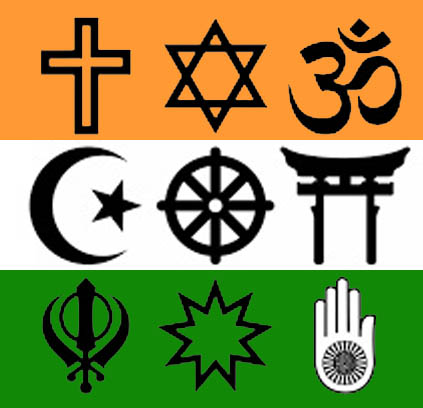
![]()
World Hindu Festivals
Festivals List of Current Year
Read more Hindu information, Pictures, Videos and Festival’s Recipes: https://worldhindufestival.home.blog
Join us on Channel of World Hindu & Health Instruction (@WorldHinduHealth)
Web Telegram in Browser : https://web.telegram.org/k/#@WorldHinduHealth
World Hindu Festivals
| Telegram Channel | Twitter | LinkedIn Page | Microsoft Teams | Other Social | WhatsApp Channel | Blogger |
All Guests Viewed since 2010: Counter:
